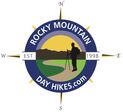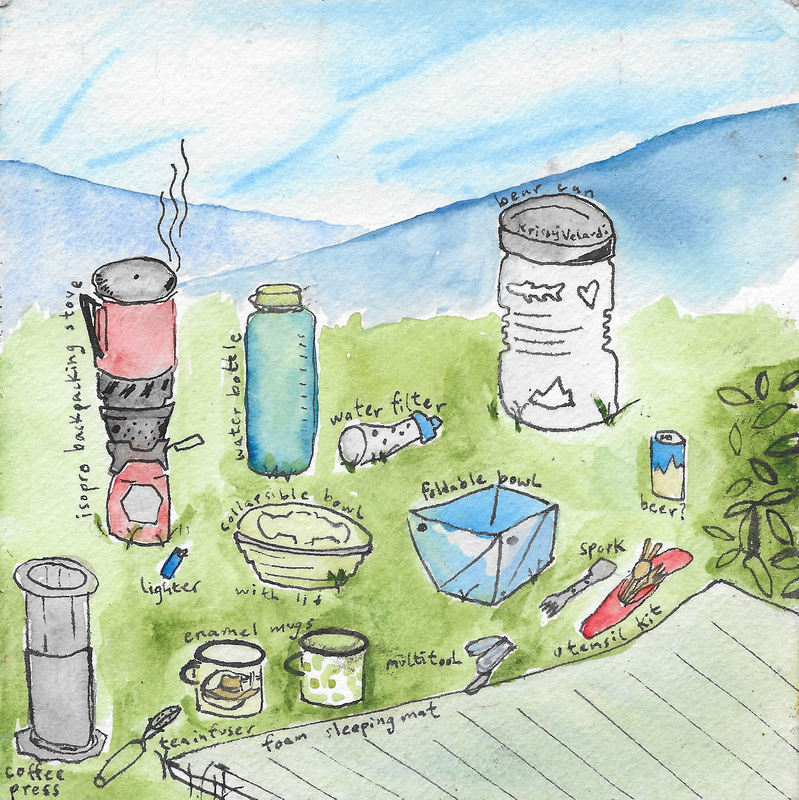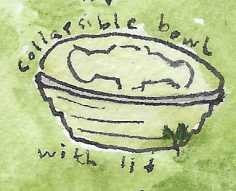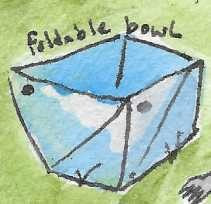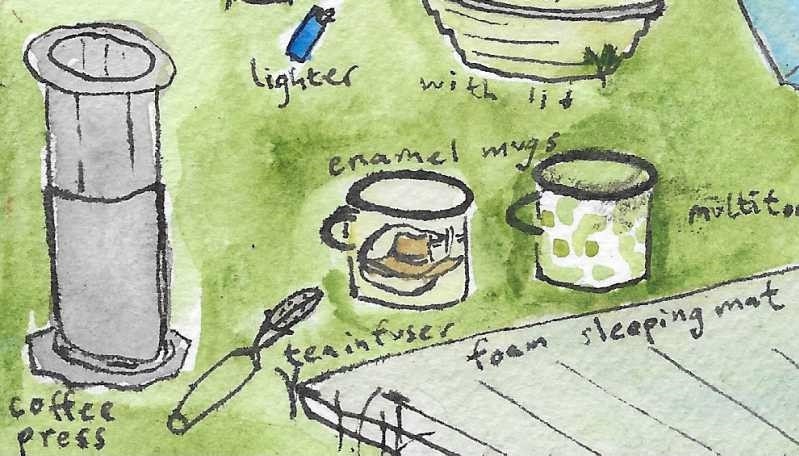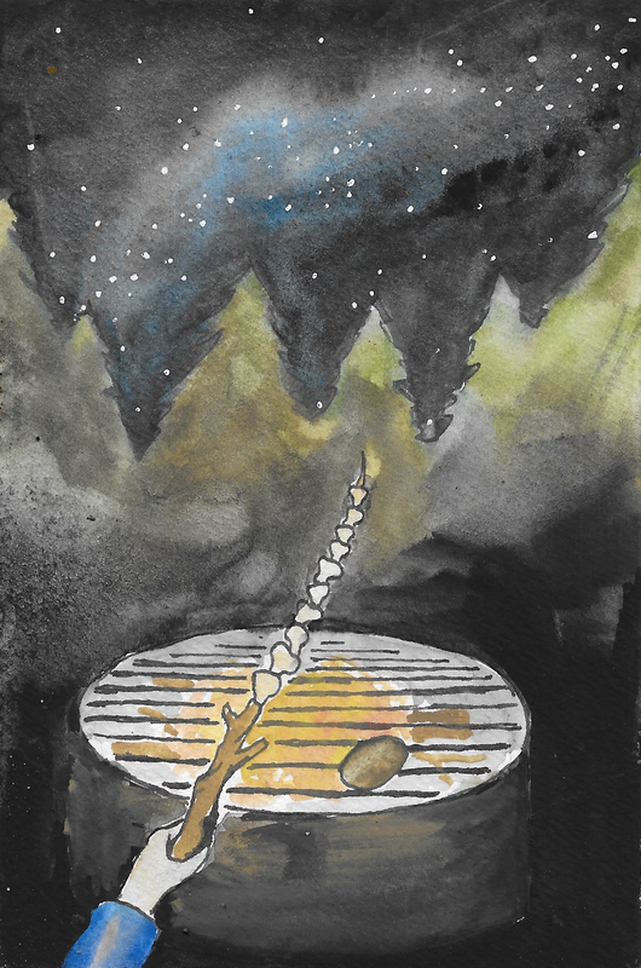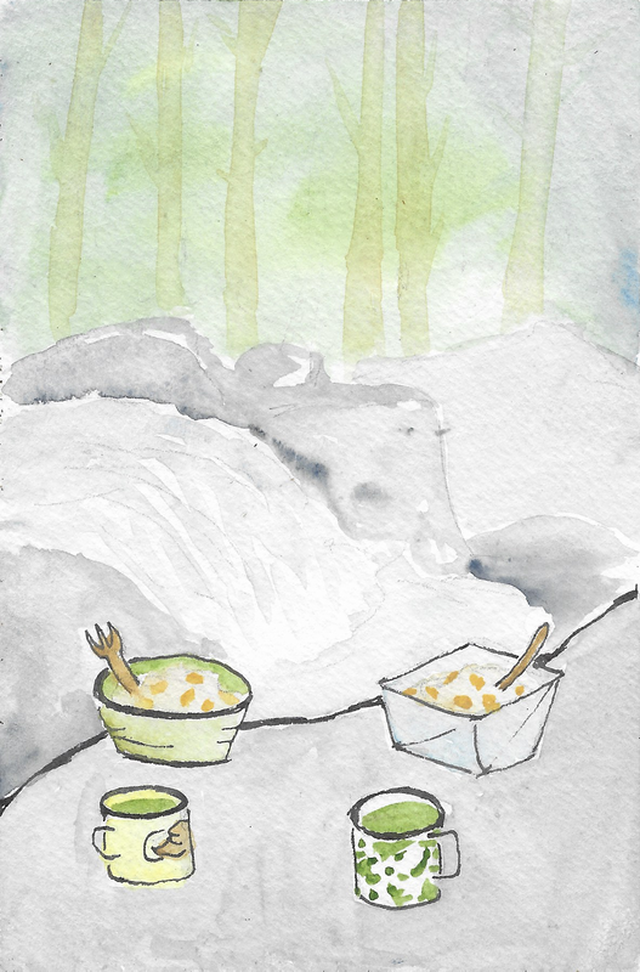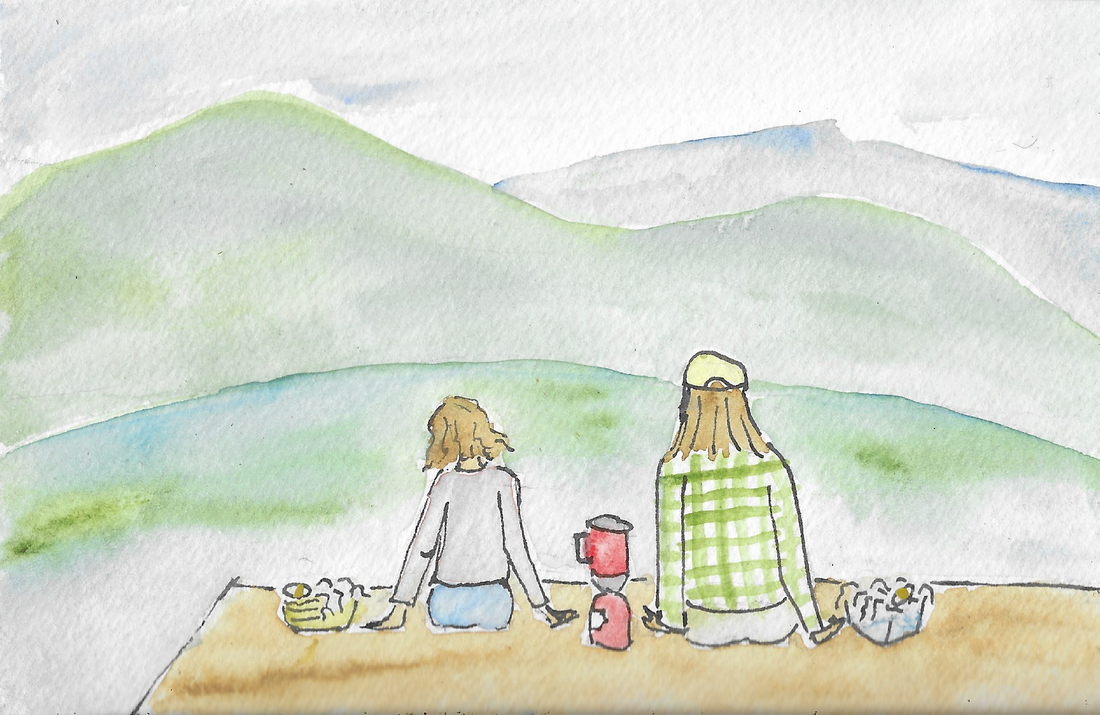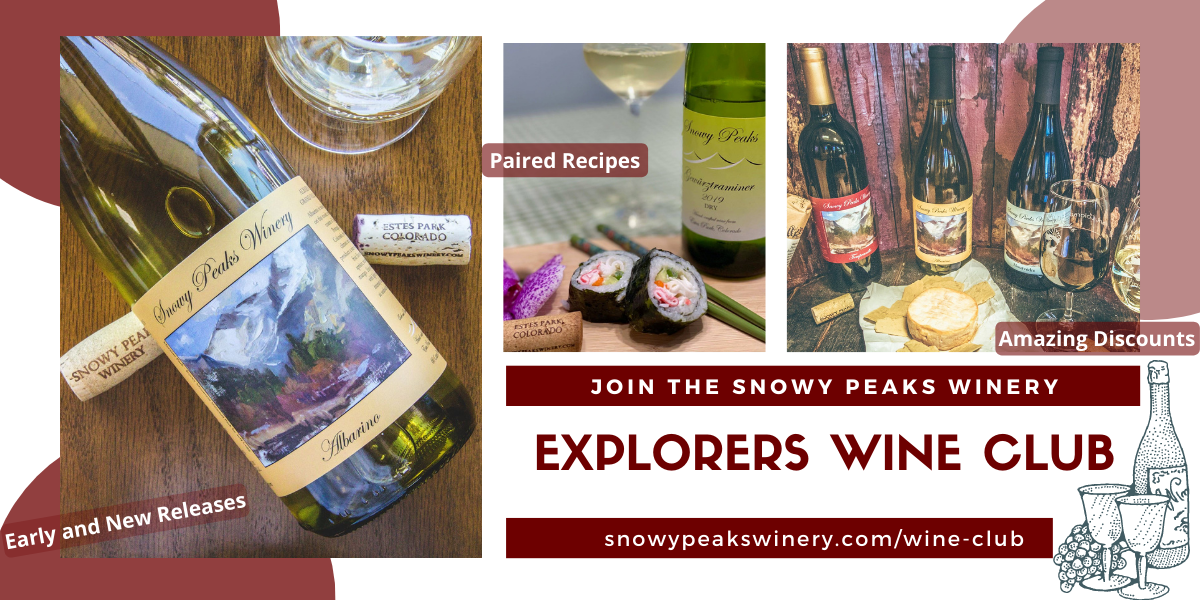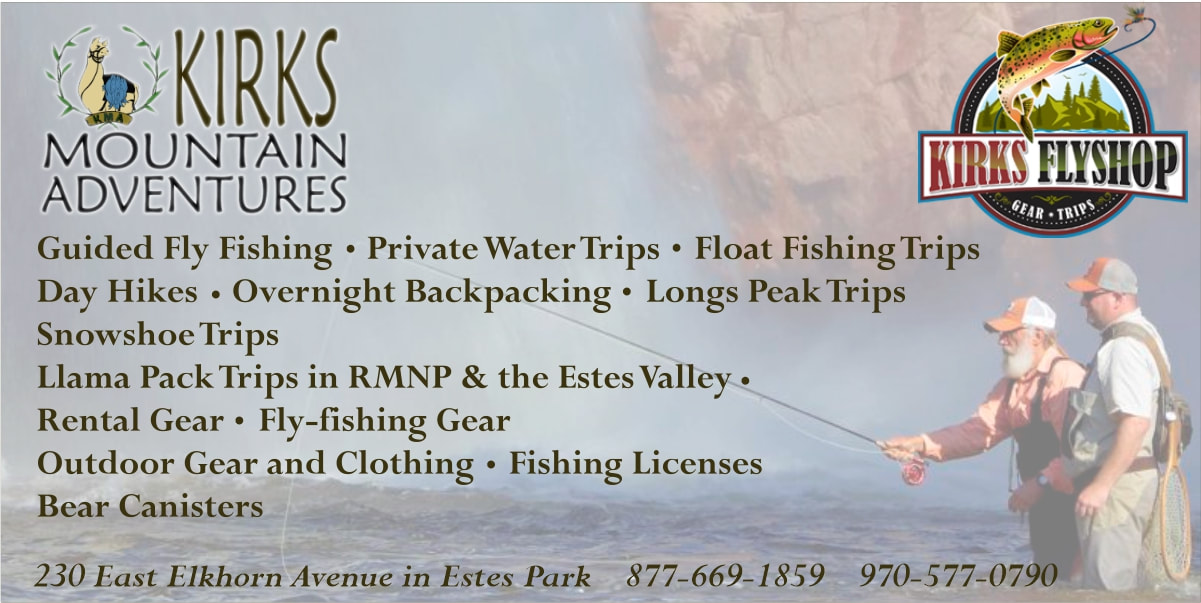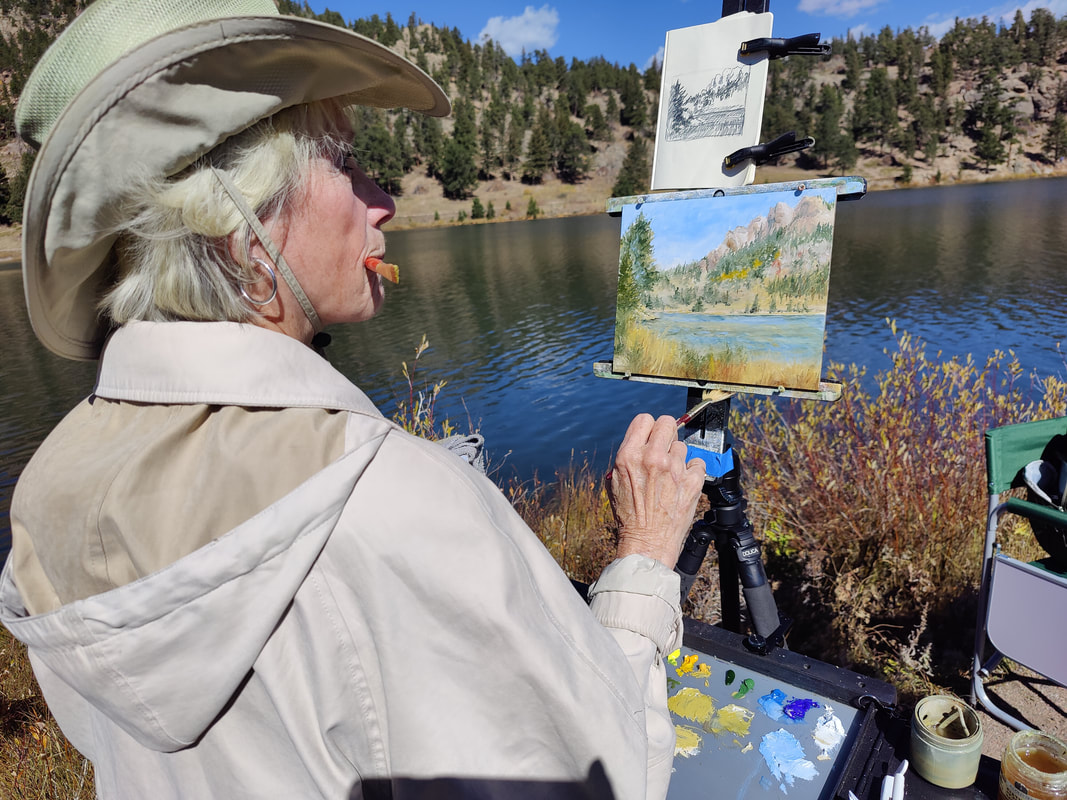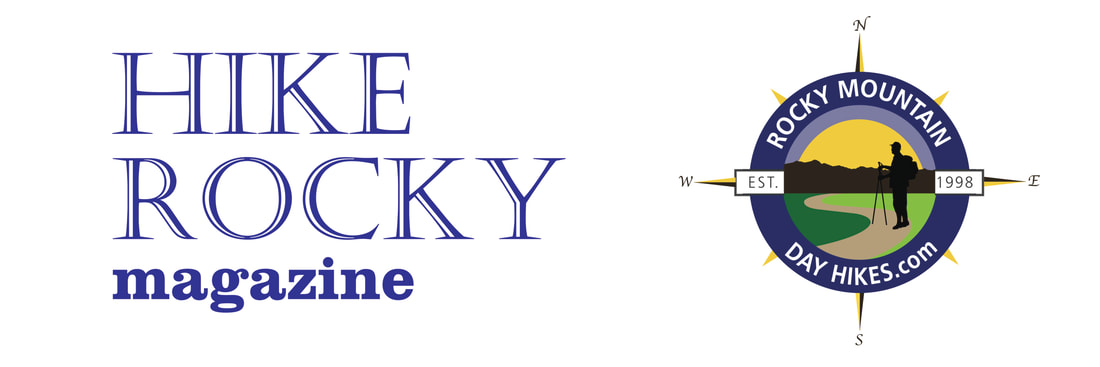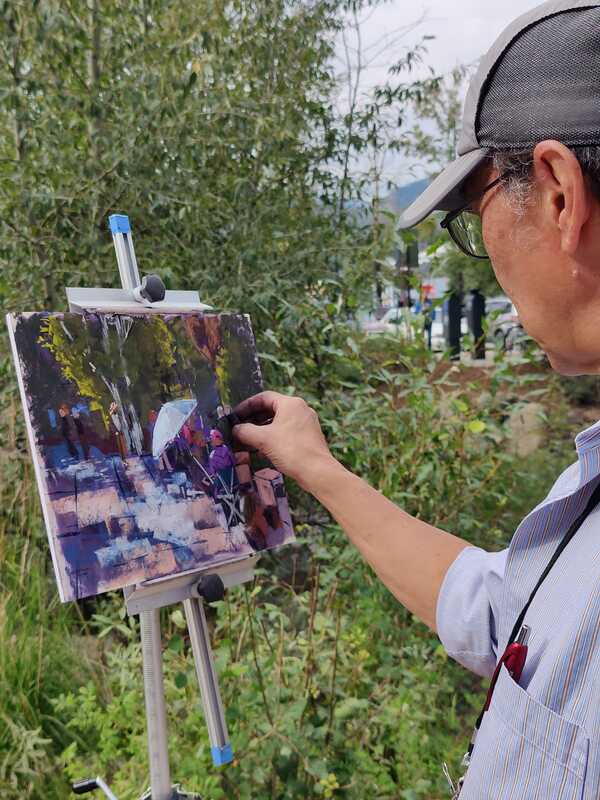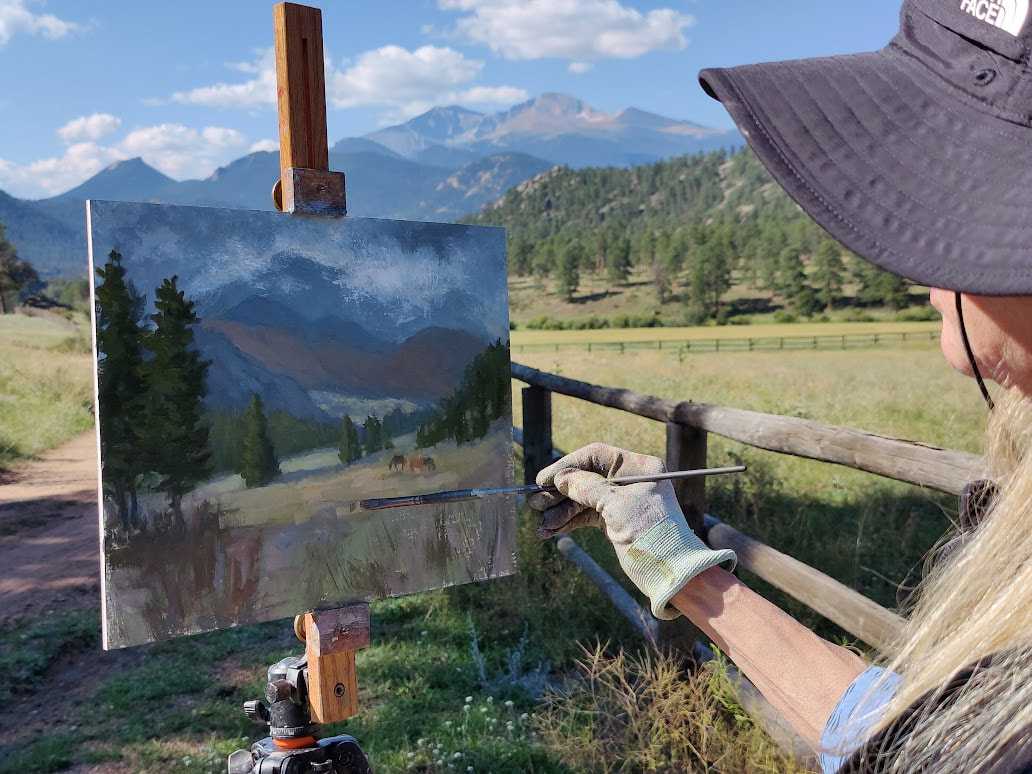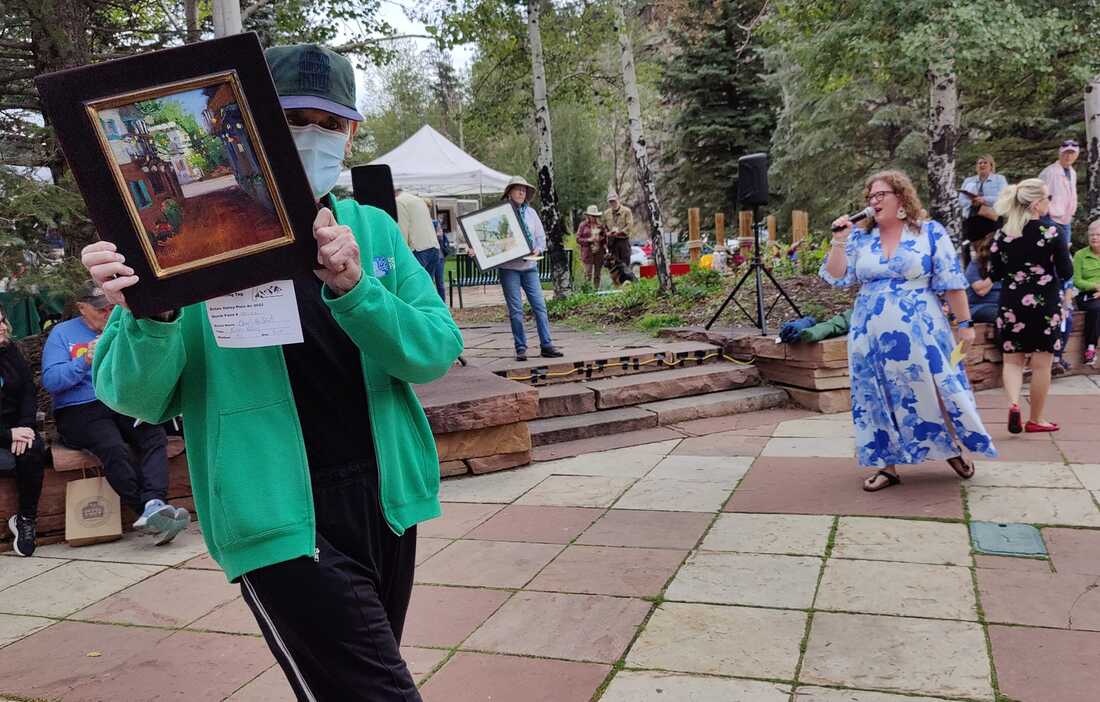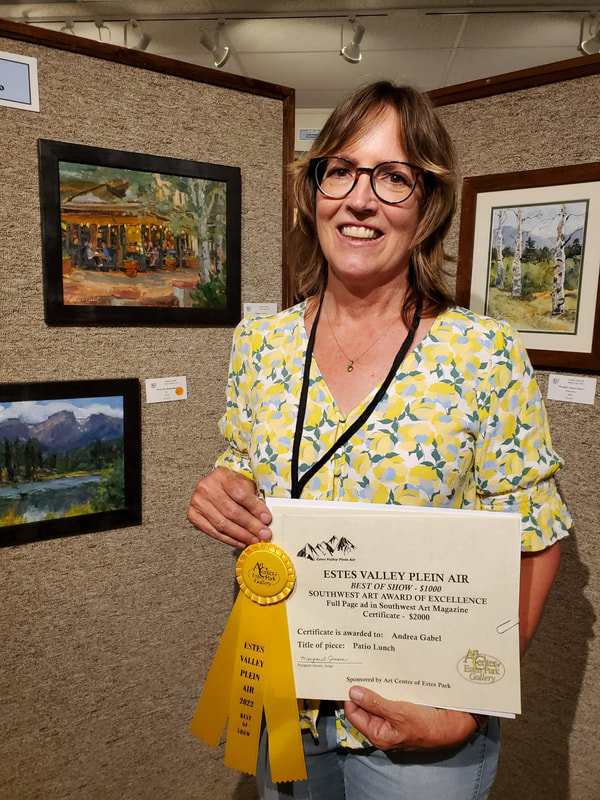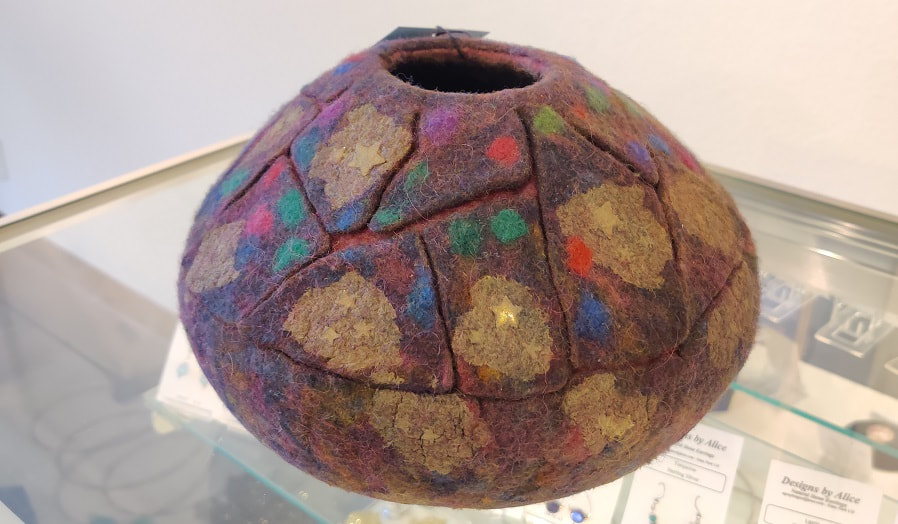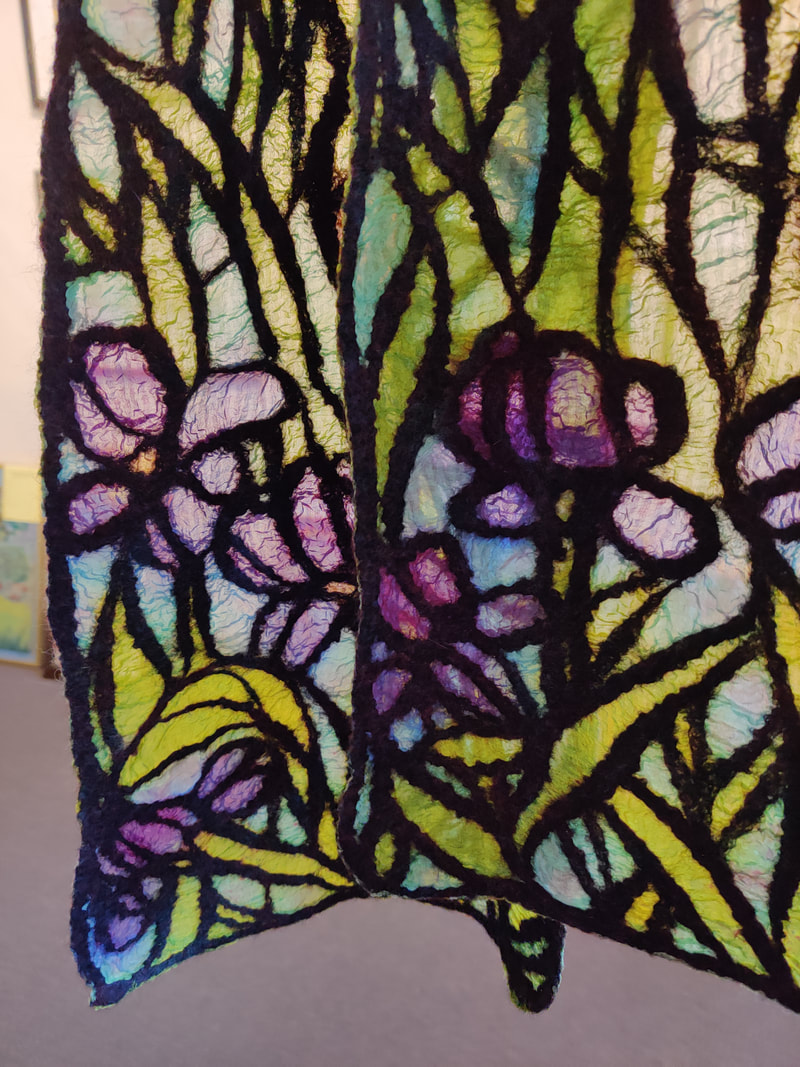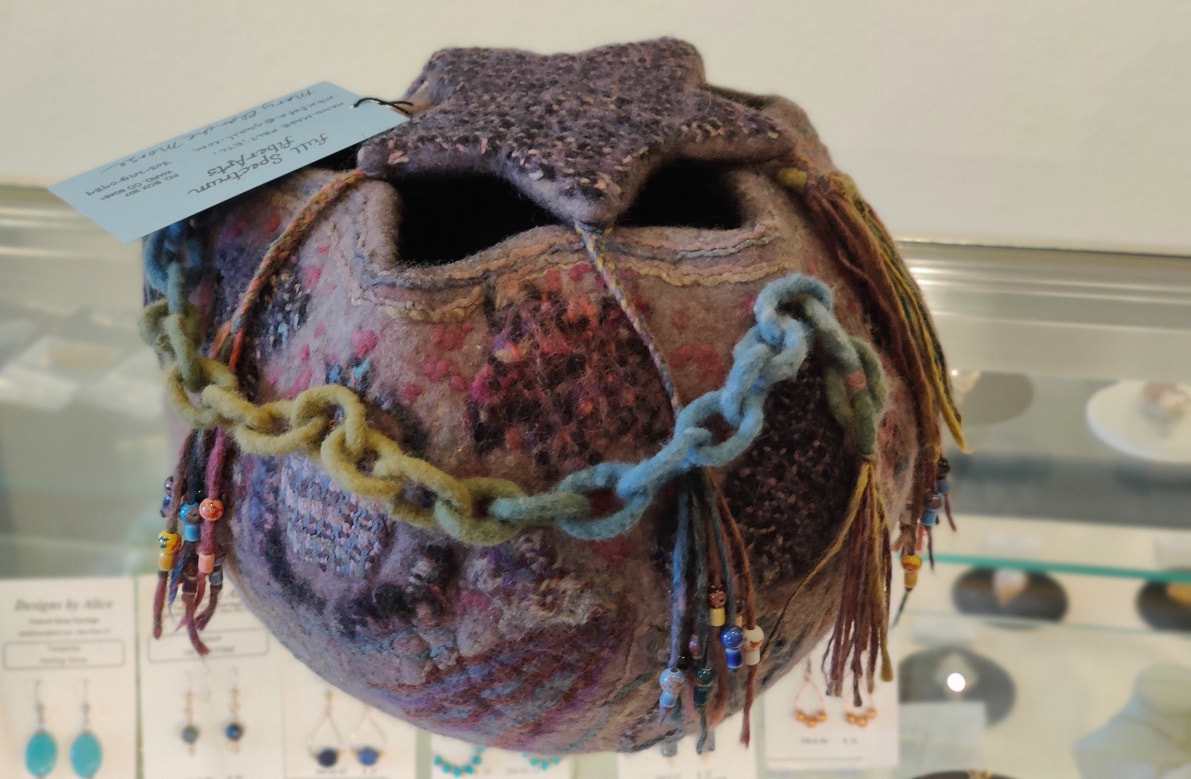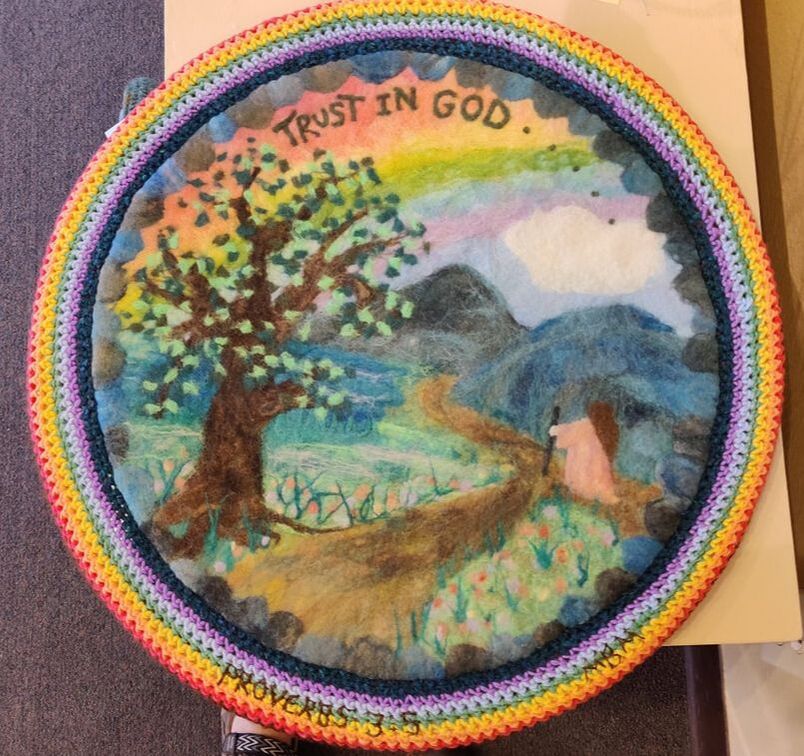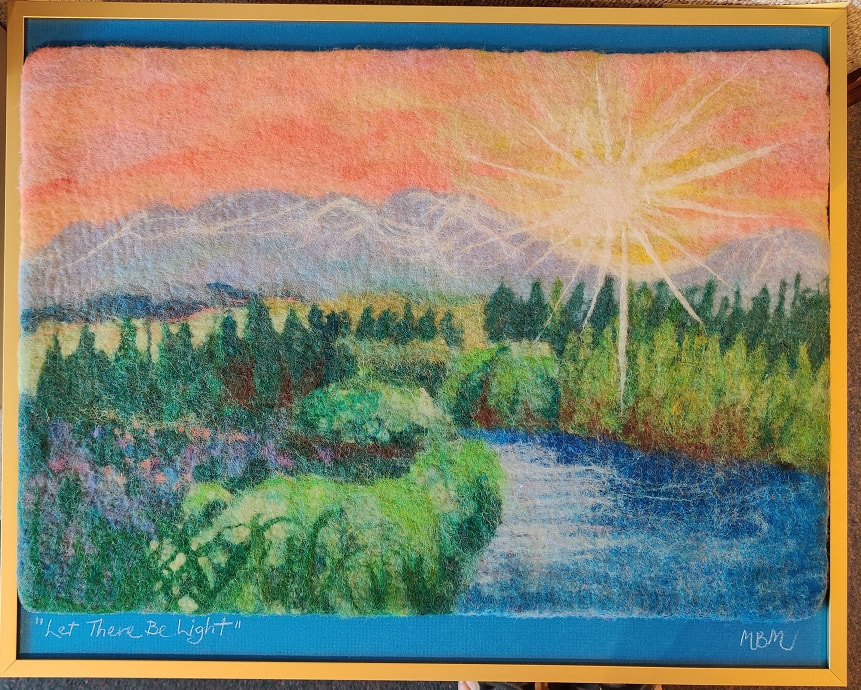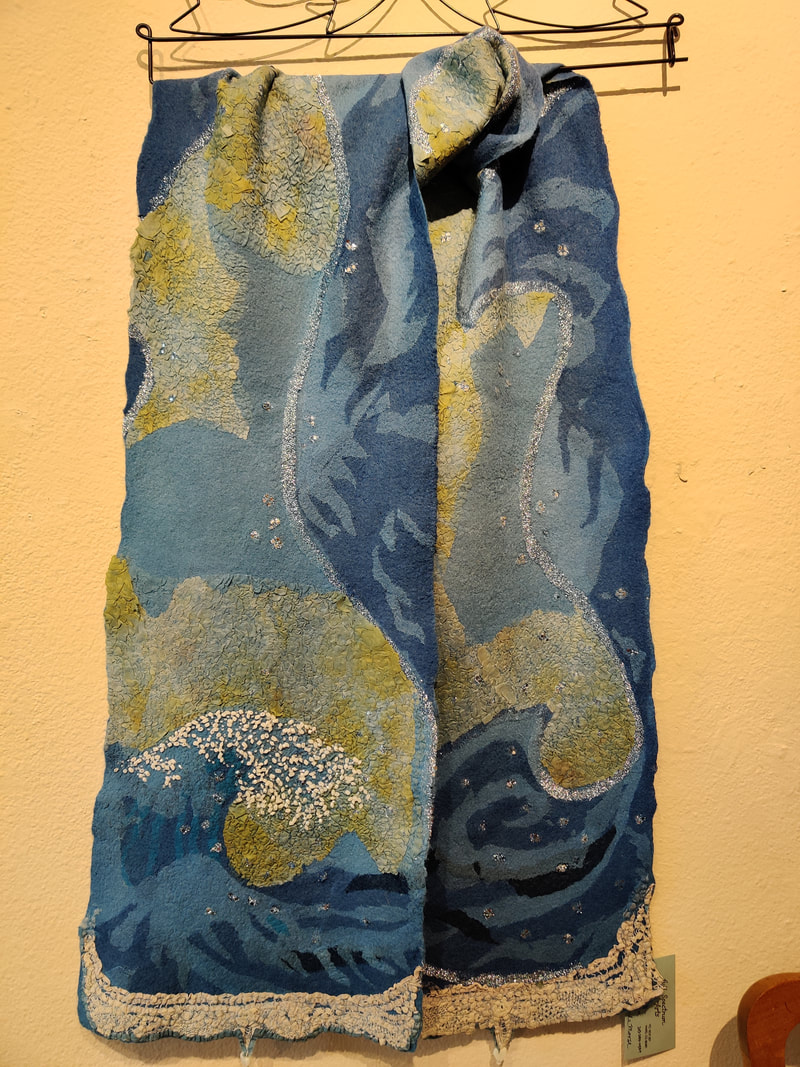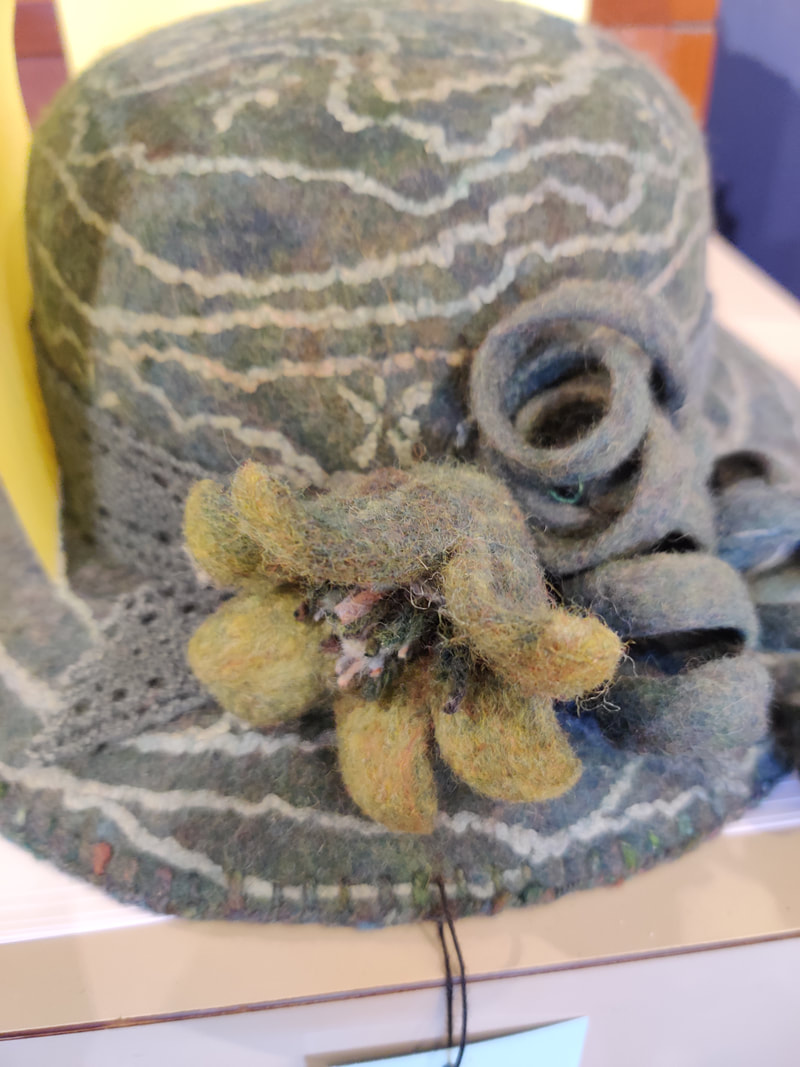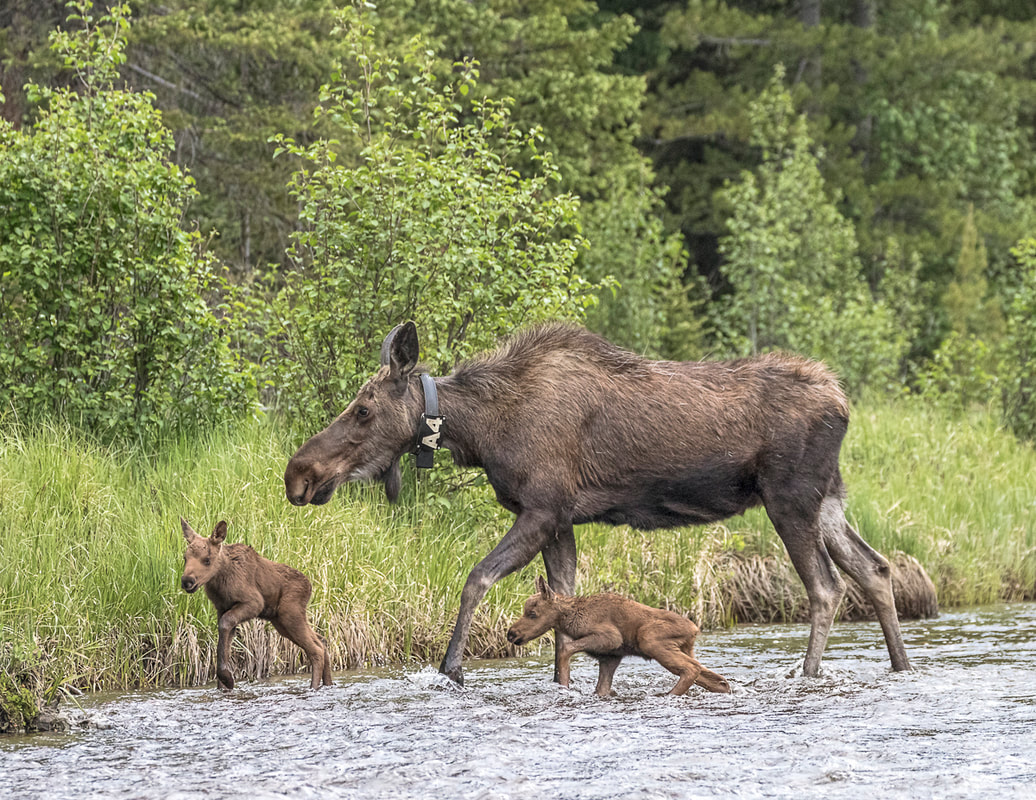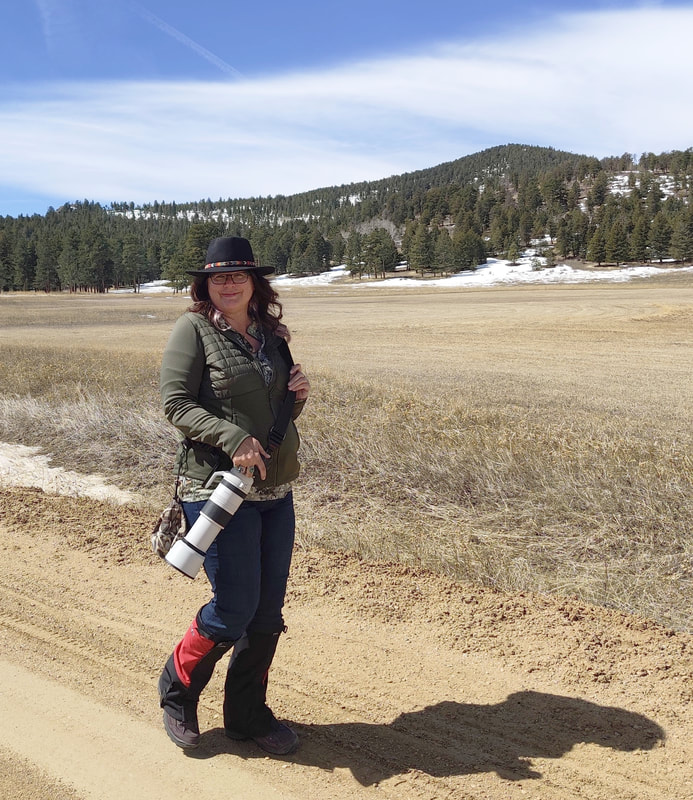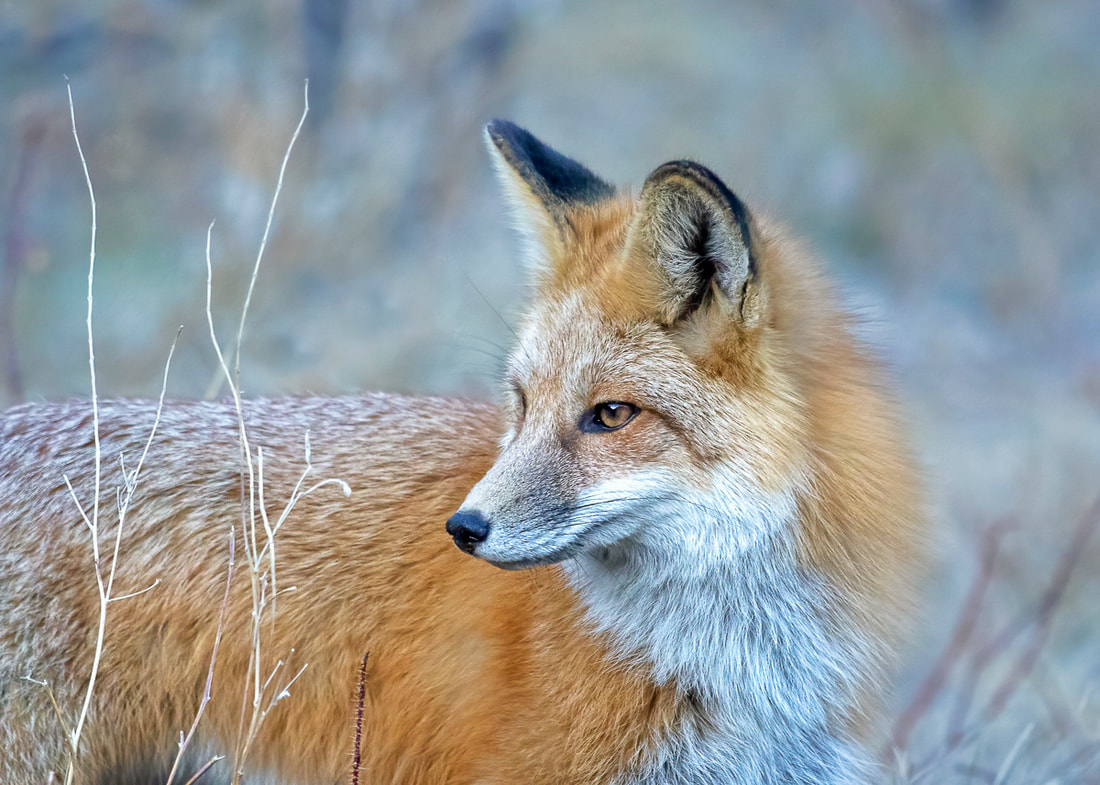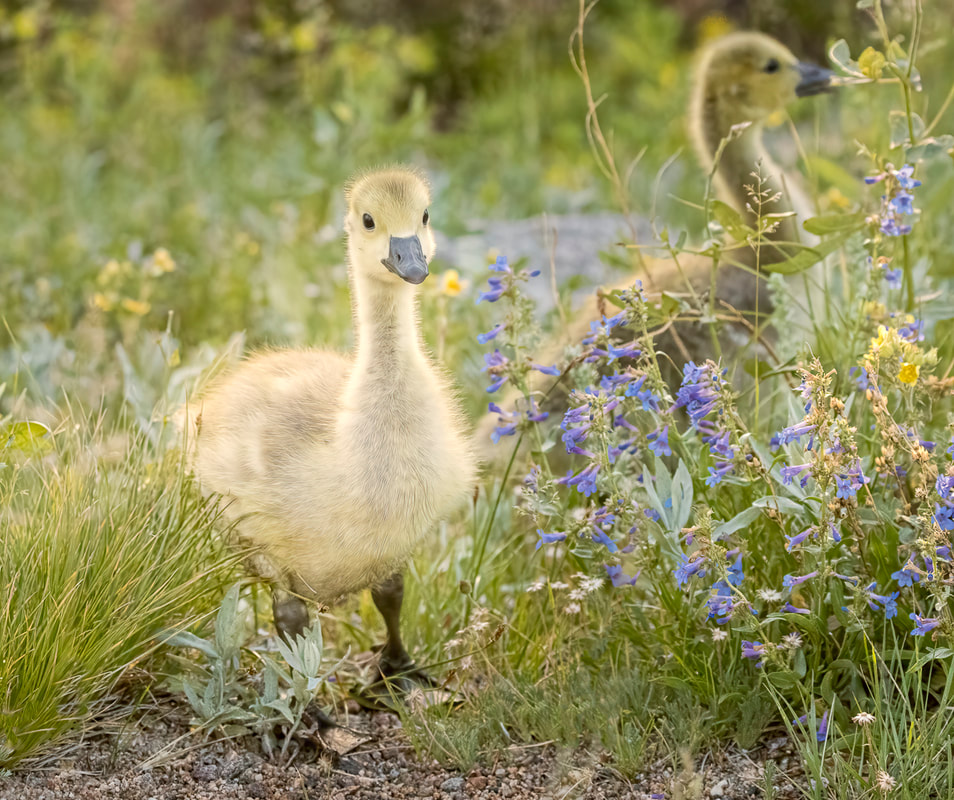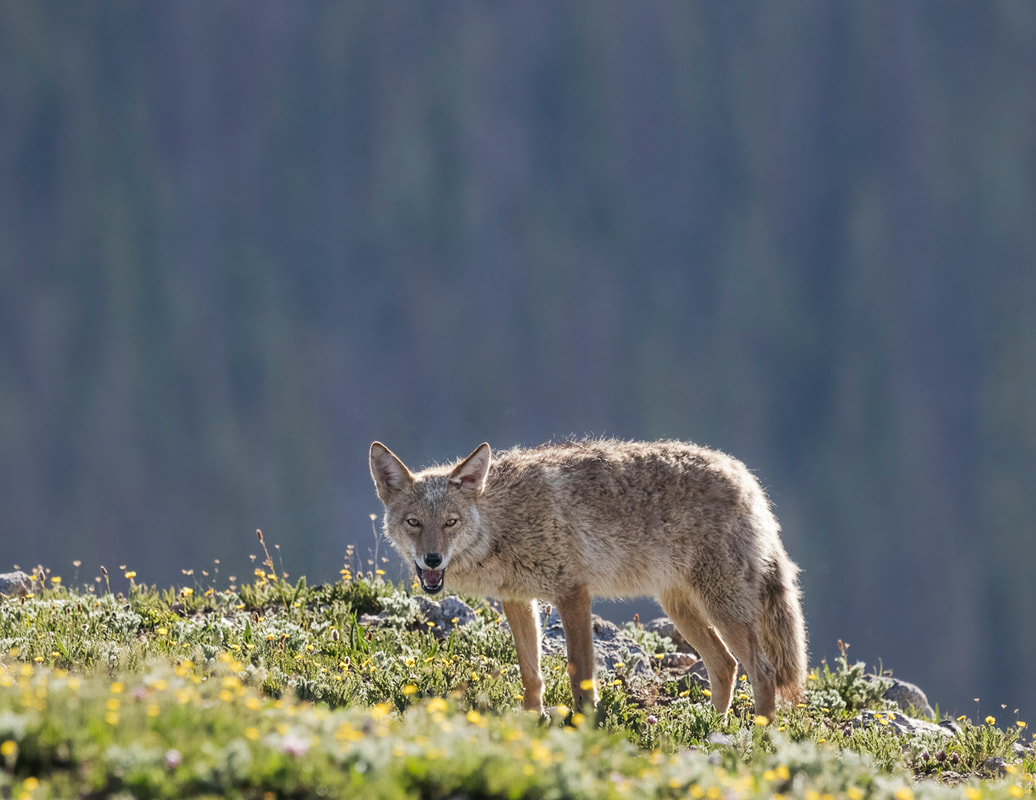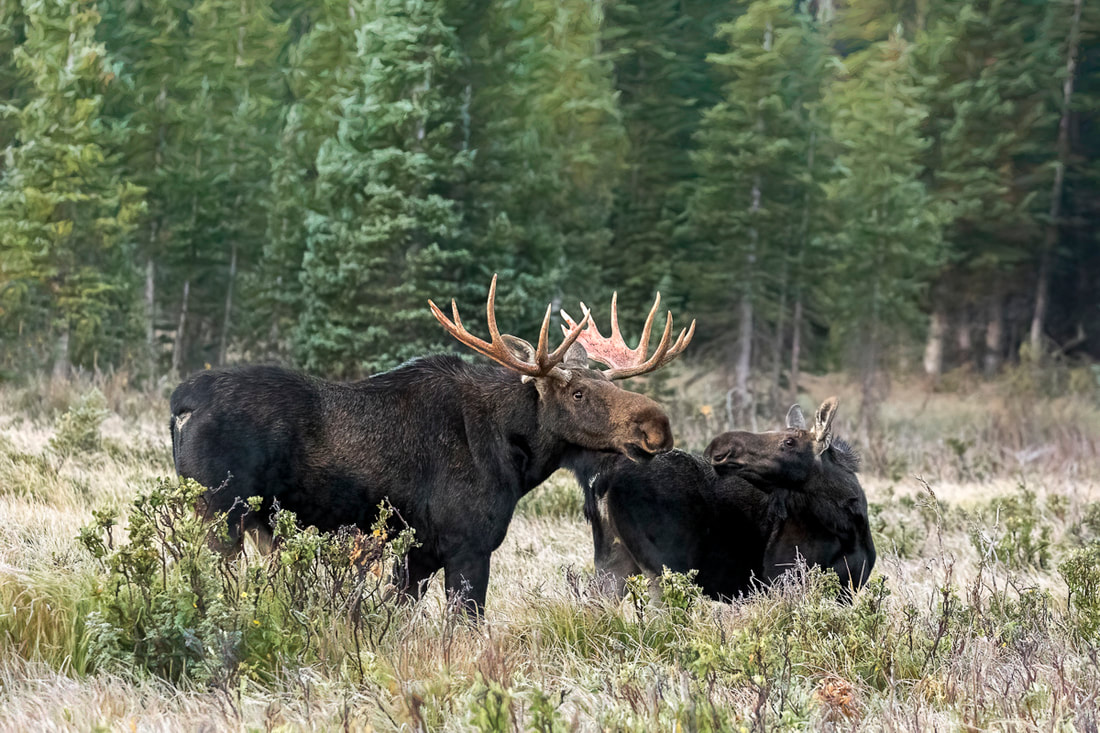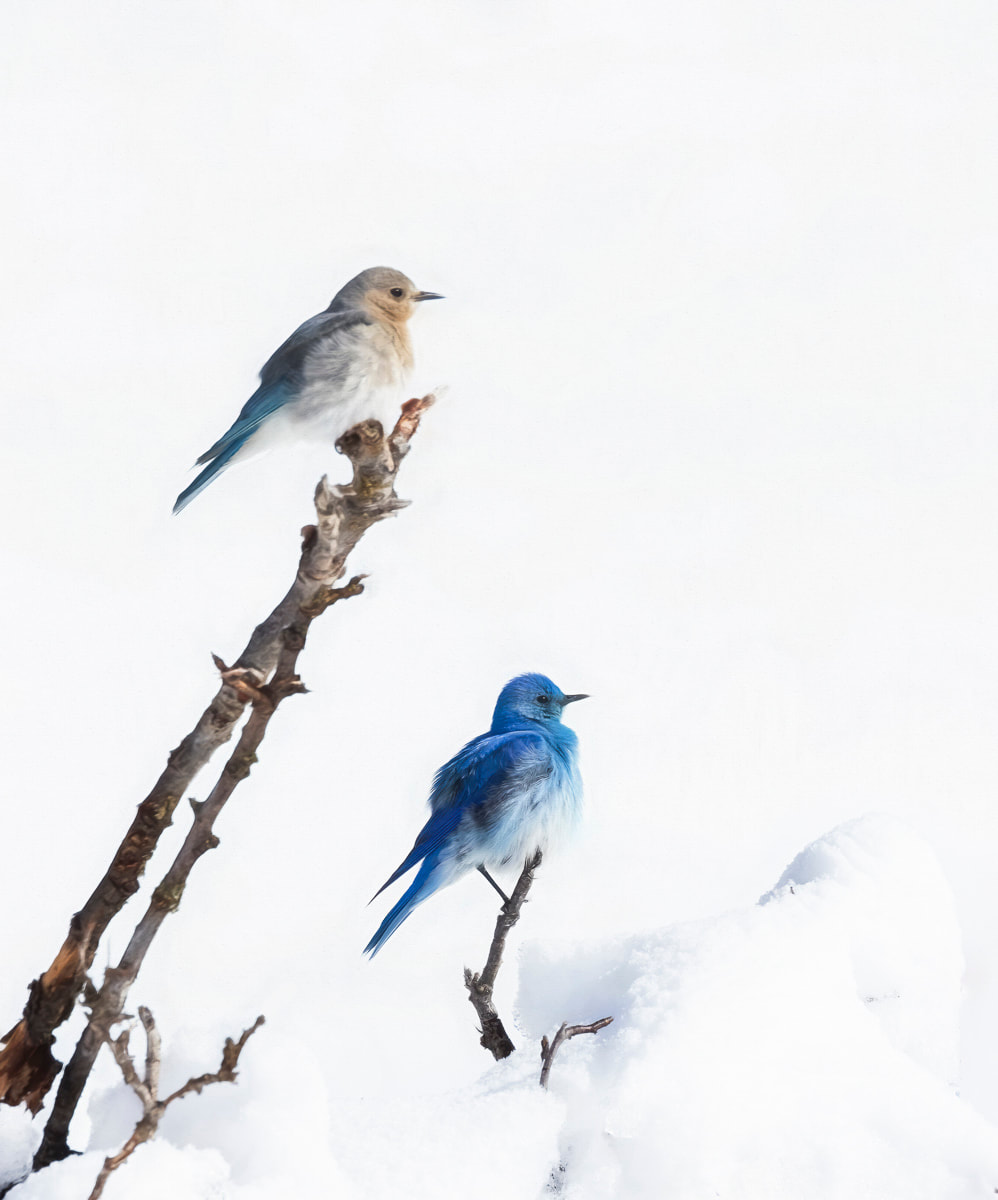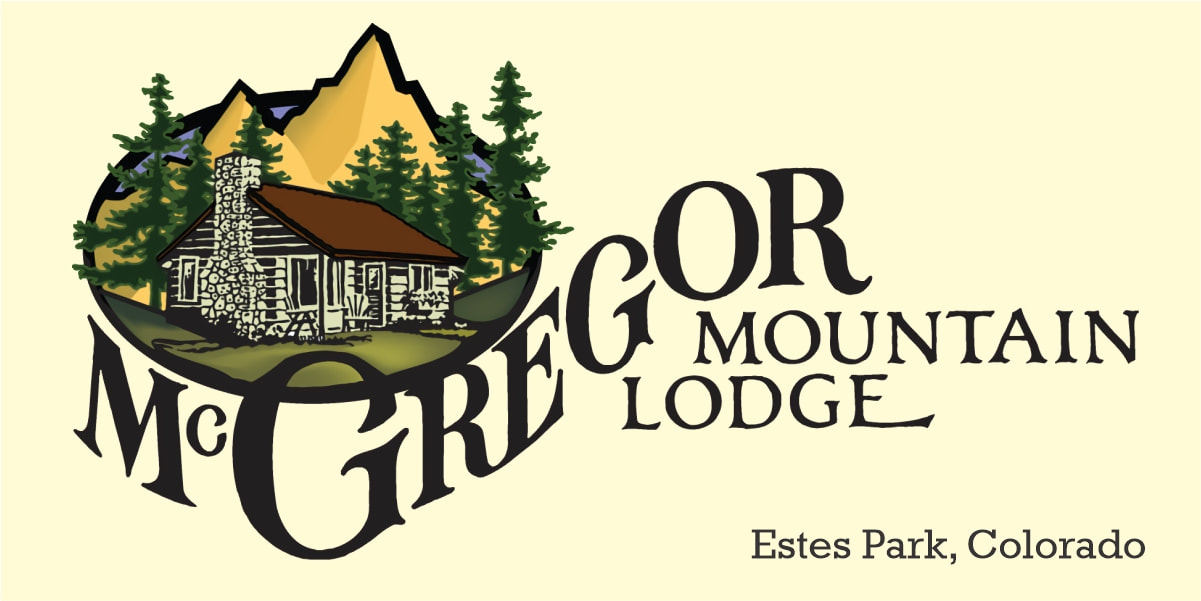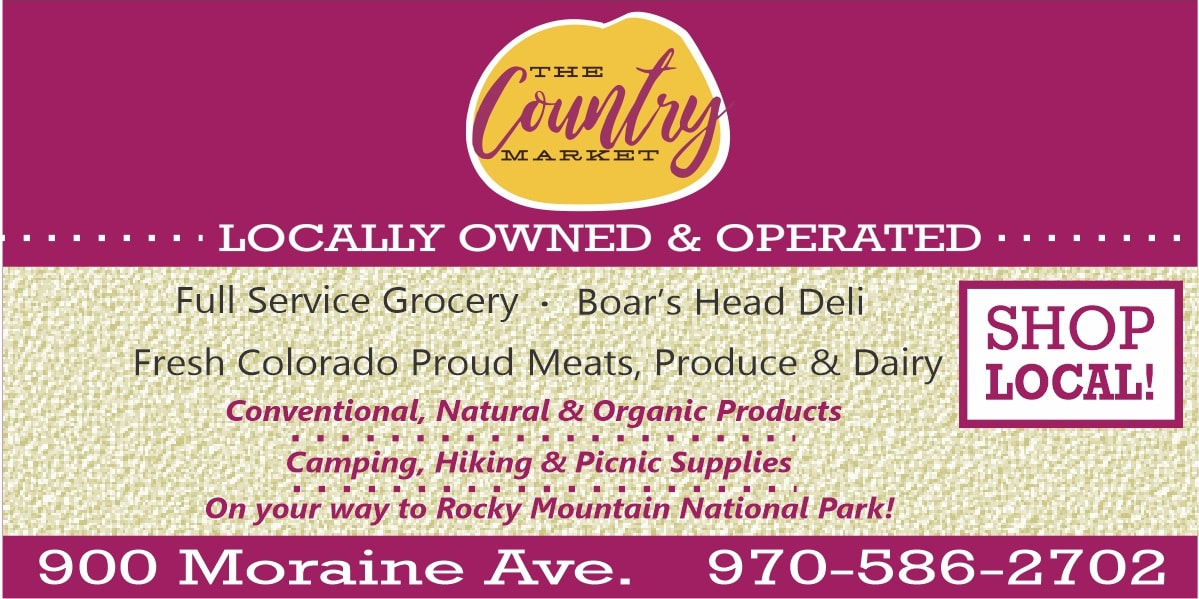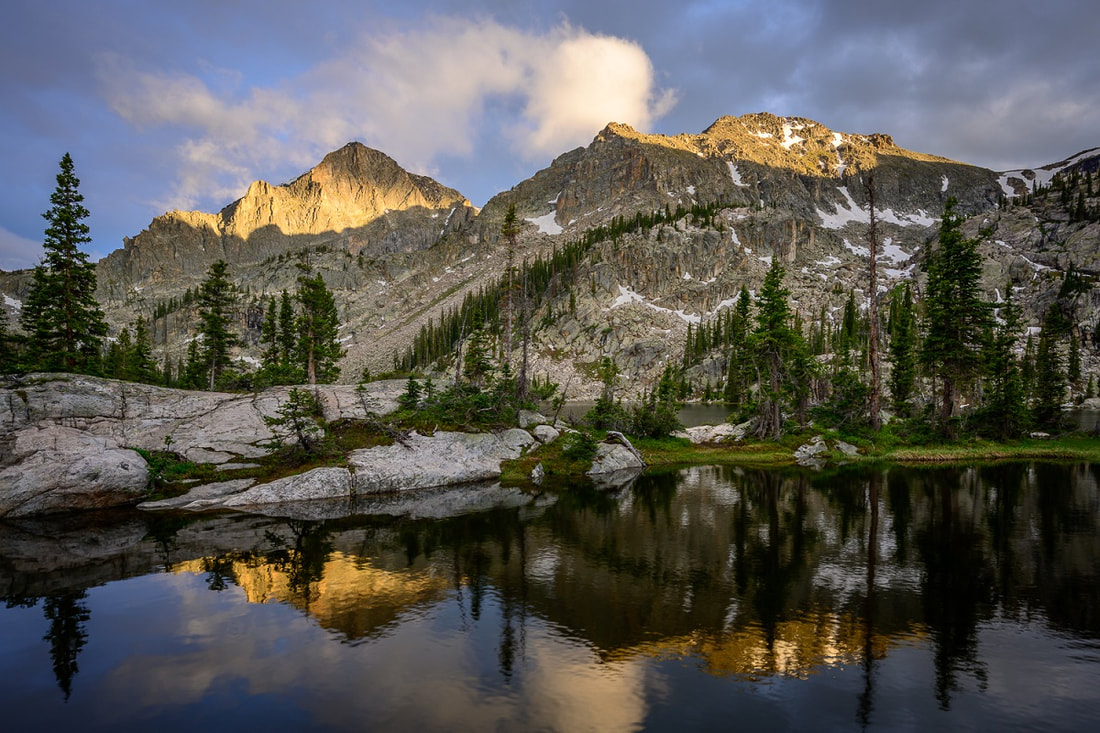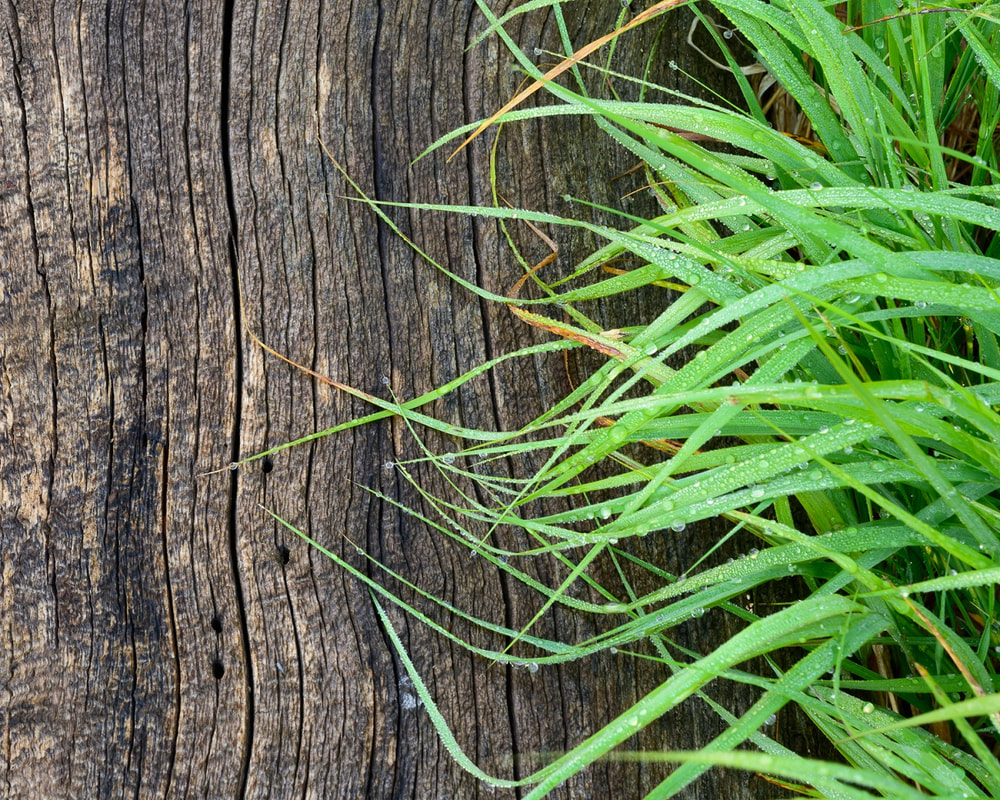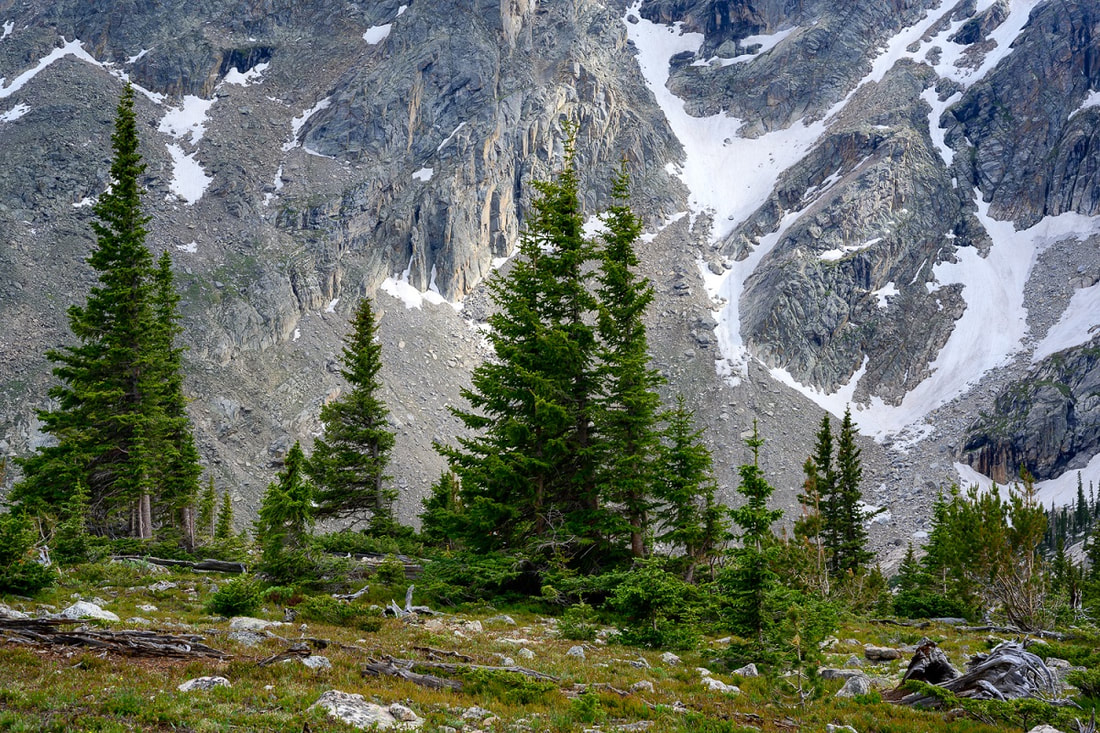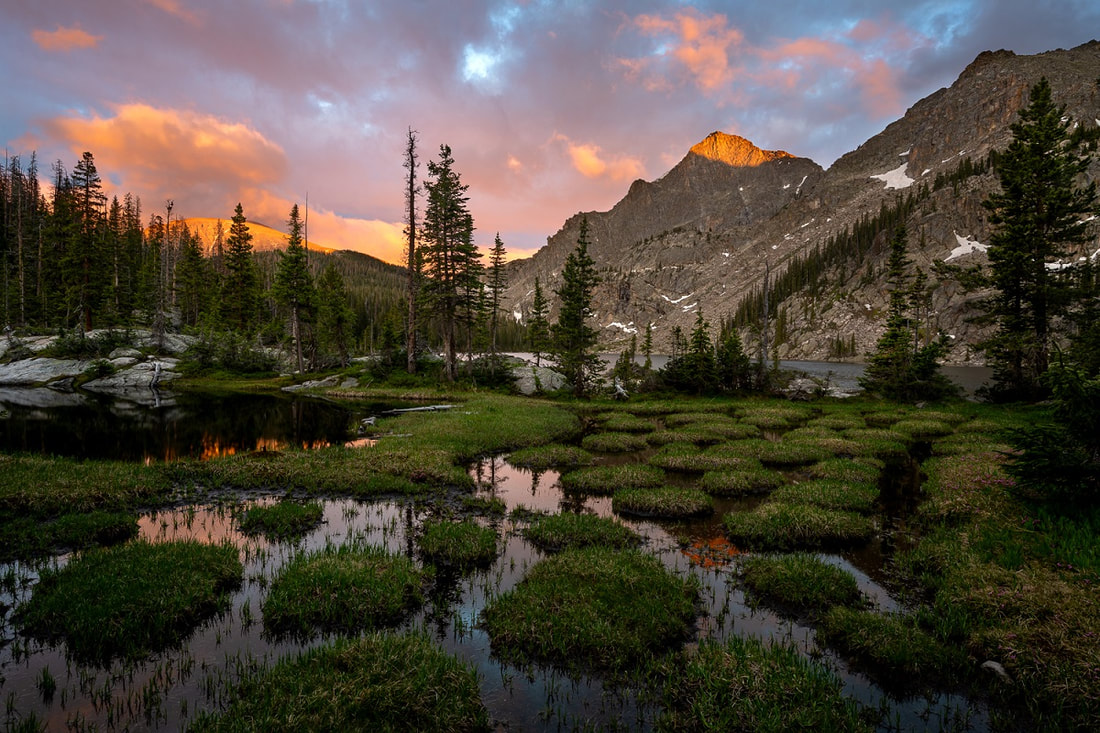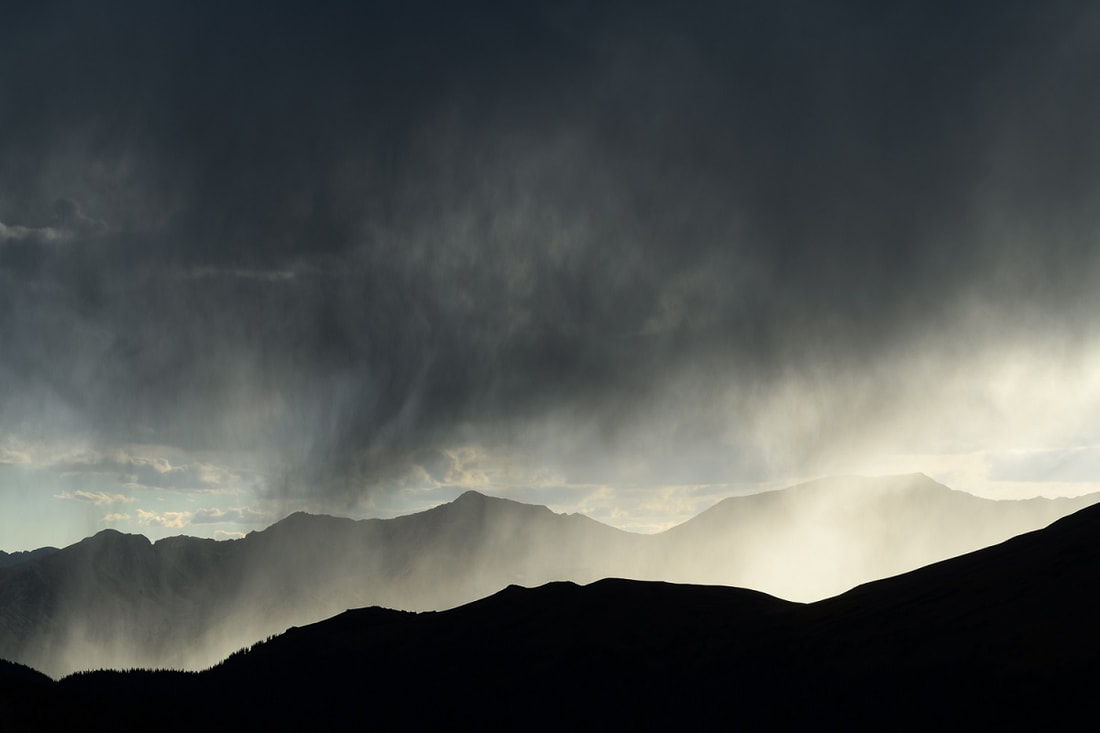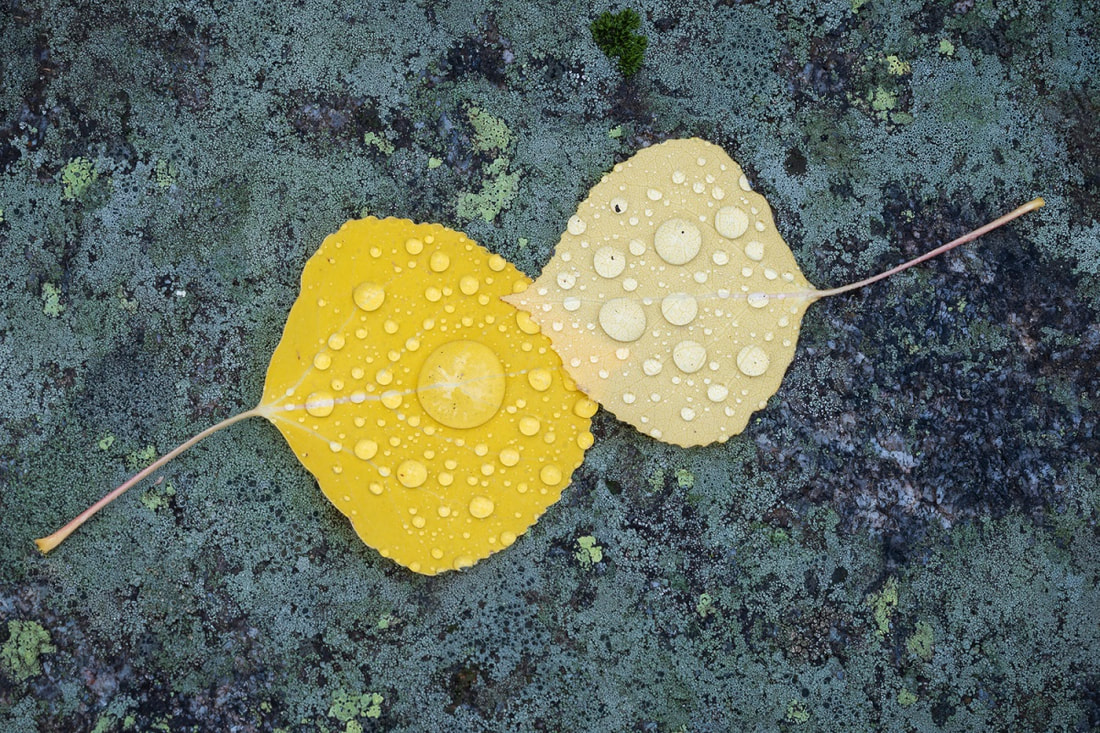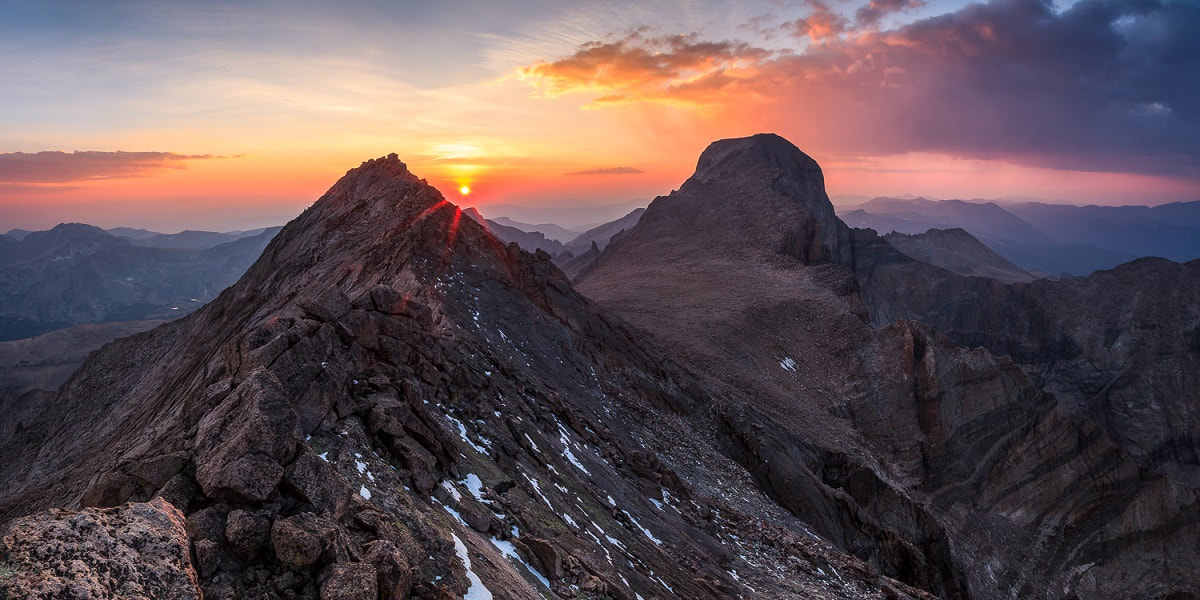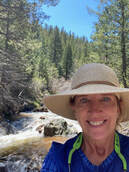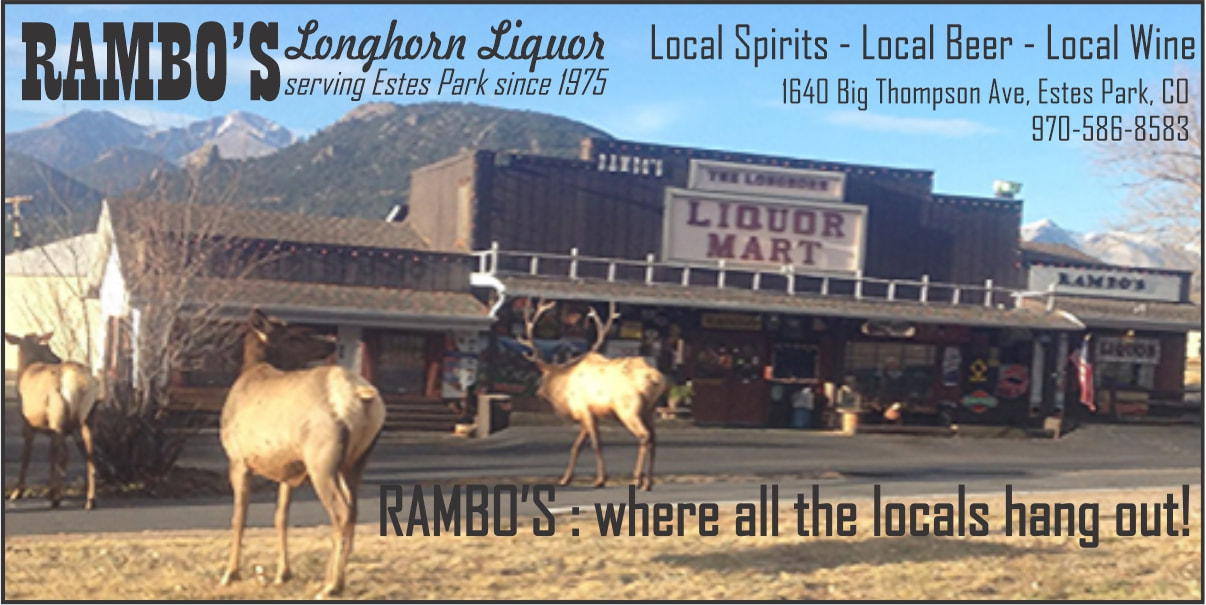|
Story and illustrations by Krissy Velardi Note: The writing and illustrations in this article are all done by myself, but it would be wrong not to credit the ideas equally to Zenith and Clay—two of the best friends anyone could ask for on and off the trail. - Krissy On a crystal-clear early autumn day this year, Clay and I ventured over Trail Ridge Road to the Grand Lake area to hike the North Inlet/Tonahutu loop over 3 days and two nights. As with any proper adventure, I could write endlessly about the magic of our journey. But here, I am just going to dive into how we fueled our bodies for nearly 30 miles in the backcountry. A lot of people opt for the pre-packaged just-add- boiling-water backpacking meals because the concept of cooking without a full kitchen can be intimidating. But to us, it is always worth a little extra love and effort to eat beautiful, nutritious home-cooked meals on the trail (plus it saves quite a bit of money!). Of course, we have had our share of flops, but the recipes here have been refined over many backcountry excursions. That being said, you don't need to hike 30 miles to try these recipes out for yourself. They're great for bringing on day hikes or even just making something quick at home whilst dreaming of the mountains. Kitchen setup 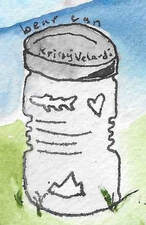 Bear can: In many mountainous areas, including Rocky Mountain National Park and the Indian Peaks, a bear canister is required for food storage. It is basically a giant plastic tub that requires opposable thumbs to open, designed to keep human food inaccessible to bears. It is an important factor in deciding what foods to bring because you need to be able to fit all of your food and other “smellables” (deodorant, toothpaste, etc.) inside of it. For that reason, a lot of our selections are purposefully compact which also serves the dual purpose of being lightweight. 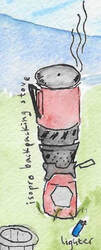 Isopro backpacking stove: Of all the camp stove styles I've tried over the years, my favorite for backpacking uses isobutane/propane blended fuel and has an integrated pot. These stoves are optimized simply for boiling water but you'd be surprised how much you can cook this way! They are also permitted in areas with fire bans because the flame is elevated from the ground. My stove is a fancy expensive windproof version, but you can find a basic isopro-fueled stove for under $20 and use any small, thin, metal pot with it. Some models have a built-in igniter, but I always pack an extra lighter since they can be finicky. Better safe than hungry! 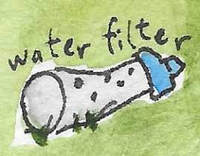 Water filter: Countless styles have been invented over the years, but I find the most compact and easiest to use to be a soft-flask style that you fill directly with water and squeeze through a filter threaded onto the opening. I bring this on any day hike with a water source, and sometimes even around town so I can fill my water bottle from the river. Remember to always filter water before you drink or cook with it, even if you're going to be boiling it.  Water bottle: I prefer to hike with a hydration bladder, but a water bottle is good to have around for the kitchen since it's much easier to pour water out of for cooking. 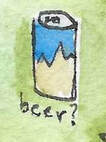 Beer?: Good for sunsets, summits, cooking, and campfires. Carefully place some rocks to hold your can at the edge of the river and leave it there for a few minutes to chill. If the refreshment of cracking open a cold one is worth the weight of carrying a can or two, then don't be afraid to indulge. Getting out there is all about enjoying yourself responsibly. Bowl: Especially if you're cooking for one, you can opt to skip this and eat out of your pot. These days I like to bring a collapsible bowl with a threaded lid and Clay uses a bowl that unfolds out into a plate for easy cleaning and packing. But in the past I used to simply bring tupperware. Just make sure whatever you choose is fairly light and sturdy. 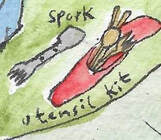 Utensils: A titanium spork is lightweight, heat resistant, and durable. This is my utensil of choice… but on this particular trip I forgot any utensil and whittled a new spork from a stick. Clay generally brings bamboo utensils in a convenient little canvas pouch to keep them all together in his pack. And of course, your household utensils work just as well outdoors too. 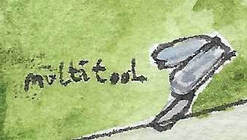 Multitool: Mostly I just cut fairly soft vegetables, but it's nice to have the option of a few blades as well as scissors for opening packages. This is what I used to whittle my utensil too. Coffee press/tea infuser: These are the best ways we've found for making hot beverages on trail while also avoiding single-use products. We measure out coffee grounds/ tea leaves beforehand and pack them in a small container. Alternately, I sometimes just bring matcha since it dissolves and therefore does not require an infuser. And if I'm feeling fancy, I'll add some powdered coconut milk to it for a backcountry matcha latte. Enamel mugs: For coffee, for tea, for sharing a beer, for side dishes, for hitting with a stick at impromptu jam sessions. Foam sleeping mat: In colder weather, I prefer an inflatable mat. But the foam ones are great for a comfy place to sit wherever you decide to make a meal. Snacks I always carry one or two granola bars per person per day in addition to a sweet snack (banana chips on this trip) and a salty one or two (pistachios and a spicy snack mix). Some ingredients, such as granola, can double as a snack if you bring extra. Plus we packed a dark chocolate bar that we shared for dessert over the two nights. The salty snacks are good for electrolytes but snacking in general is extra important because your body is going to want a lot more calories when you're working it like this. It's really important for a fun backpacking experience to find calorically-dense foods that you truly enjoy! Day 1 Breakfast: Trailhead breakfast burritos (propane stove) As we prepared the rest of the food and finished up packing for our trip, we used a cast iron skillet on a two- burner propane stove to make breakfast burritos at Grand Lake. To power the first bit of our journey, we cooked up some sweet potatoes, red onions, black beans, and eggs,wrapped it all up in tortillas, and put them back on the skillet to toast the outside. It was simple but packed full of nutrition to get us ready for a big adventure! Lunch: Peanut sauce veggie wraps (no stove) Prepare at home: To a half-full jar of nut butter, add a pinch of black pepper, a hearty shake of garlic powder, a squirt of hot sauce (to taste), and a splash of something acidic (lemon/lime juice or apple cider vinegar). Top it off with soy sauce or hoisin sauce, being careful not to make it too thin, especially if you choose soy sauce, since you want to maintain a spreadable consistency. Give a good stir, then close the jar, shake it all up, and toss it in your bear can. A standard size jar makes about 4–6 servings if you really like to heap it on. On the trail: Take out a tortilla and spread a saucy stripe down the middle. Cut/rip up a liberal amount of crunchy veggies (we used bell pepper and carrot) and pile them on. Roll it up, using a bit more of the peanut sauce as glue to hold the wrap together. I've tried pre- making these wraps, but they get a little soggy so it's best to just assemble them on trail. Dinner: Wild mushroom rice bowls (isopro stove + campfire [optional]) At home: Fill a bag with dehydrated mushrooms (I love the exotic blend we would buy at the farmers market in the summertime, but be sure not to include any that are too large as they take much longer to rehydrate), sesame seeds, dried seaweed (we typically use wakame), salt, pepper, and umami seasoning. Pack another bag or jar with some instant white rice. Although I prefer brown rice, the instant white rice seems to cook much better with just boiling water poured over it. In another small jar, add some miso paste. On trail: Well, we packed the dehydrated mushrooms but ended up finding such an abundance of wild mushrooms (see note) while still on Forest Service land before we entered Rocky. We picked a few of those to use instead! Our first campsite had a fire ring and small wood fires were permitted, so we made a fire and skewered our mushrooms to roast while we prepared the rest of the recipe In the pot of your isopro stove, boil water (1:1 ratio with the total amount of rice you'll prepare) and the contents of your mushroom-seaweed-spice blend as well as a heaping spoonful or two of miso paste. Pour a serving of instant white rice into each bowl. Once the contents of the stove have come to a boil, turn the heat down and give it just a minute or two more (making sure the mushrooms have time to rehydrate) and then pour them all together into the bowls of rice. Stir everything up and let it sit for a few minutes. Chop up a bit of zucchini into small pieces to add some crunch then toss it on top once the rice has absorbed all of the water. Note: Do not ever consume wild foods you have not identified with 100% confidence. If you have any doubt whatsoever, leave it. If you are intending to forage, carry a field guide and collect responsibly. Don't gather a significant por'tion of what you see or more than you'll eat. And, always pack a backup rather than relying on being able to forage. Day 2 Breakfast: Mango cobbler oatmeal (isopro stove) At home: Mix quick-cooking oatmeal with cinnamon, coconut milk powder, and brown sugar, being sure to leave some nuggets of brown sugar. Put the mango (or your fruit of choice) in a bowl or mug to keep it from getting bruised in your pack. On trail: This was a big day of hiking, so in order to get going early we ate some granola bars while packing up the tent then hiked a few miles before stopping to cook breakfast by a cascade. Pour a serving of oatmeal into each bowl and cut up the mango while bringing a full pot of water to a boil. Add some of the boiling water to the oats and let sit while you use the remainder to make a pot of tea/coffee. Once the oats have absorbed the water to your desired consistency, sprinkle the top with some granola and uncooked oats. Lunch: Peanut sauce veggie wraps 2.0 (no stove) It is really nice to have a go-to lunch that doesn't require a stove in case you want to keep it speedy but also because that mountain sun can be hot midday! Additionally, it can be extra windy above the treeline which makes it difficult to use most stoves. We brought enough peanut sauce for two rounds and then used bell pepper again but swapped in zucchini in place of carrot to mix things up a bit. Other veggies that work well are cucumber, red cabbage (cut into large pieces at home), leeks, and bean sprouts. Dinner: Mushroom mash (isopro stove) This wasn't what we had intended but after hiking 12 miles all above 10,000' with the weight of our packs, we simply wanted to go to sleep. So this is what happened: I'm the type to get a little upset when hungry so I always bring some instant mashed potatoes (dubbed “hanger tates”) as a preventative measure. They get used on every trip, and it keeps me pleasant enough that my friends continue to want to go backpacking with me. At home: Fill a bag or jar with instant mashed potato flakes, salt, pepper, and garlic powder. On trail: Bring water and dehydrated mushrooms to a boil over an isopro stove. Add some potatoes to each bowl. Once mushrooms are properly hydrated, distribute the contents of the pot amongst the bowls and feast. Day 3 Breakfast: Cobbler oats 2.0 (isopro stove) We didn't bring a second fresh fruit, so on the morning of day 3, we added some banana chips and extra granola to the top of our cobbler oats and they were delicious this way as well. Another pot of tea helped to wake us up. Lunch: Miso mushroom ramen (isopro stove) We planned to have this for lunch on trail and carried the ingredients in our bear can, but it was scorching hot as we hiked through a burn scar in the midday sun. So we sat with our toes in the river, sharing a cool beer and snacking on some granola bars, and decided to wait until we got off trail so we could add a soft-boiled egg and cook on the beach of the lake. However, we have previously brought eggs on trail, wrapped in a clean sock or bandana then packed firmly in a tupperware. At home: We used the same mushroom/ seaweed/ spice mix and miso as we did for the rice bowls we had for dinner on Day 1. On trail: Fill pot just over halfway with water then add flavorings and bring to a boil. Once boiling, add an egg for each person and slightly lower heat. Let the rolling boil continue for about five minutes. Carefully remove the eggs from the hot broth and place them in a mug of cool water to chill for a few minutes. Add 1 or 1.5 packets of instant ramen noodles (we forgo the flavor pouches that come with them in lieu of our homemade mix) to each bowl and pour the hot broth over them. Let sit a few minutes, periodically separating the noodle “nests” as they soften. Chop up some fresh crunchy zucchini as a topping. Peel the eggs, add them to the bowls, and enjoy with a view! 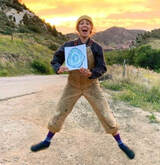 Krissy Velardi is a nature-loving nomad who was carried to Colorado on the wind. When she is not dancing through the mountains, she is daydreaming about them and often laying those whimsical visions down on paper. To see artistic interpretations of her other wanderings, go to krissyvelardi.com or @acorngirldesign on instagram The publication of this piece of independent and local journalism was made possible by Snowy Peaks Winery and Kirk's Mountain Adventures, both of Estes Park.
1 Comment
Edited by Barb Boyer Buck, HIKE ROCKY magazine’s managing editor, in partnership with the Art Center of Estes Park Pat Sebern is the current featured artist at the Art Center of Estes Park with her show “Blaze of Color” (September 30-November 7). According to her biography, “I lived in Denver and began painting there in the 70’s. During those years I was primarily involved in Western art…especially as it portrayed mountain men and black powder events. “New job opportunities took me to Seattle and then Dallas where my favorite subjects became wildlife and landscapes. “Through these jobs and transitions in creative projects…I have worked in several medias…watercolor and gouache and large canvas murals painted with acrylic. But my two favorite mediums are oil and pastel." Her bio continues: “I find them the most versatile, timeless and inspiring of all the painting disciplines. I have no formal training but over the years have participated in many workshops and taught several classes. “In the past 3 years, I retired and moved back to Colorado from Texas. Now I am exploring new opportunities to paint, become affiliated with inspiring groups of artists, and enjoying the beautiful scenery that Colorado has in abundance. One rule I always try to follow…make sure the paint water and the coffee mug are far apart!” On a crystal-clear day in mid-October, HIKE ROCKY magazine was lucky enough to film Pat as she painting “en plein air” (in the open air) at Lily Lake. Her intricate, detailed painting featured one of her favorite subjects to paint - Colorado aspen. The next day, HIKE ROCKY visited Pat at the Art Center, where she was volunteering. She gave us a tour of her show. Both videos are available to view on the following page. The Art Center of Estes Park is located in Upper Stanley Village (across the parking lot from Safeway) and will be hosting a new show that opens on November 11 featuring the photographic collage art of Laura Davis of Estes Park. “Colossal and Intimate: Nature, Abstraction, Imagination Through The Artist's Lens” will run through December 19. For more information on the Art Center’s upcoming art shows, classes, and events, visit https://www.artcenterofestes.com/ This piece was produced in partnership with the Art Center of Estes Park.
edited by Barb Boyer Buck, HIKE ROCKY magazine's managing editor in partnership with the Art Center of Estes Park Every August, well-known artists from all over the country converge on Estes Park for the Estes Valley Plein Air competition, exhibition, and sale. These juried and invited artists have a limited amount of time to paint "en plein air," a French term meaning "in open air." They painted on location in Rocky Mountain National Park and within 50 miles of the Estes Valley. Special events in conjunction with EVPA include a poster/postcard and wine label contest, a nocturne paint out opportunity, a miniature contest, a group paint out, an educational program, and a Quick Paint at Riverside Plaza in which artists have a limited amount of time to complete paintings that are then auctioned to the public. Artists were juried into the show based on applications received January 2-April 3, 2022, 11:59 p.m. PST through the website, onlinejuriedshows; 37 artists were selected to participate. They all had between August 19-24 to paint as many pieces as they could and turn in up to six pieces – three for general entry, one nocturne, one miniature, and one piece to held be in reserve. None of the pieces could exceed 18'X24” before framing. Renown plein air artist Margaret Jensen of Estes Park served as the judge for the competition and awards in several categories were presented in the exhibition's opening, held at the host organization's gallery, the Art Center of Estes Park, on August 26. The show will remain up at the Art Center's gallery through September 25, 2022. More than $11,000 in cash prizes were given to the winners (listed below) in this event, which was sponsored by the Art Center of Estes Park, Plein Air Magazine, and Southwest Art Magaine. General Entry Competition Best of Show: Andrea Gabel, for “Patio Lunch” Award of Excellence (2nd Place): Richard Sneary, for “Estes Park Overlook” 3rd place Award of Excellence: Lynn Mehta, for “Under the Sky” Honorable mention: Connie Schmidt, for “Waiting for Moose” Artists' Choice Award: Richie Vios, for “Batman and Sundance” Miniatures: Award of Excellence: Richard Sneary, for “The Barrel” Honorable Mention: Lee McCloud, for “In the Rain” Nocturnes: Award of Excellence: Lorie Merfeld-Batson, for “Back at Camp” Honorable Mention: Ann Salviazu, for “View from Mary's Lake” Gold Award (Art Center of Estes Park Board of Directors): Cliff Austin, for “Family at Lumpy Ridge” Silver Award (Mayor's Award): Connie Schmidt, for “Waiting for Moose” Poster & Wine Label Contest Award: Richard Sneary, for “Copeland Falls” Quick Paint, first place: “Park Theater,” by Richard Sneary Quick Paint, second place: “Stops along the Way,” by James Sampsel Quick Paint, third place: “Anticipating Fall,” by Cecy Turner Visit the Art Center of Estes Park to see this amazing show and pick up a piece of the Rocky Mountains to take home with you! The gallery is open every day from 11 am to 5 pm for this exhibition.
In partnership with the Art Center of Estes Park Mary Morse has been working with fiber for most of her life. She learned to knit in the first grade and has been felting her own materials for more than two decades. She is the current featured artist at the Art Center of Estes Park, in conjunction with the FACE OF FIBER in the Rockies annual show. She delights in creating designs inspired by nature and coloring her raw materials with natural dyes, including aspen leaves. One of her specialties is making felt hats. In the video above, Mary demonstrates how to felt a flower adornment on one of the hats featured in her show, “From the Creation: Natural Inspirations.” Mary is hosting Cari Cook as a guest artist in this vibrant exhibition. The show runs through July 19 and thereafter, photographer Scott Dorman of Estes Park will be featured July 22-August 3, 2022. To see the entire schedule, visit the Art Center of Estes Park’s website. "The classroom crafts got her started with natural dyeing and working with wool and silk. She had the idea that she needed to learn feltmaking. She signed up for a hat making class with Anne Sneary, who was the famous feltmaker in Boulder at that time. She made her first felt hat, wore it, and became a hat person. Soon she started making felt full time and her little business “full Spectrum fiber Arts” was born. For the next 10 years, she and her husband Fred traveled all over the country to art and fiber festivals. She marketed her handmade felt hats, tapestries, scarves, and other fun stuff. She taught classes, and got some cool awards. She had a mail order catalog of felt items. She kept experimenting and innovating with many techniques and goals. In 2004, she and her husband acquired the general store in Ward, and 'full Spectrum fiber Arts' was based out of there for 14 years in a gallery in the back. "When they sold the store and “retired,” she started showing her work at The Glass Tipi, the wonderful little gallery across the street from the store in Ward. After she was invited back to the Winners Circle in the FACE of Fiber Show at the Art Center of Estes Park, she joined and began showing there too. Her fiber art is also at The Old Gallery in Allenspark. These three galleries keep her plenty busy in her off grid studio back in the woods at 9000 feet where she and her husband live in small cabin. Years ago, she started a “round alphabet series” of tapestries with one-word titles. She got to the letter M for music. Now she is continuing her series with N- Nature, O – Owlets, and P – Proverbs 5:3-5. Stay tuned! She also creates stained glass felt and art inspired felt scarves. She works with fibers dyed with aspen leaves, flowers, and plants. These natural materials get her going, and the possibilities are endless
The Photography of Deena Marie CzechBy Barb Boyer Buck “My job as a wildlife photographer is to leave wildlife wild… just as I found them," said Deena Marie Czech. It's an engrossing, time- consuming activity that keeps her very busy most early mornings and at dusk in Rocky Mountain National Park. Her goal is not to “capture” wildlife in a quick photo that can be taken from the car or jumping out to get a quick shot of a herd of elk; Deena draws on her lifetime of observing animal behavior and incredible patience in her photography. Deena was born in Minnesota but has made the Tahosa Valley home for the past 30 years. “I grew up 'Midwest practical,' with parents that had a low threshold for goofing off, arts, or creativity. When I moved to Allenspark, it was always a challenge to stop doing all the responsible things and just go play in the woods. “Well, that's over! Let the dust bunnies and dishes pile up cause I'm going to go look for river otter.” She learned tracking skills from her father; family “vacations” were centered around the hunting seasons he participated in and always involved hiking and camping. She's very comfortable in the woods. “When the moose first came to Allenspark around 1999, I had only a tiny point and shoot camera,” she explained. “I had a keen interest in moose so in between my responsibilities, I would sit and watch them. Any picture I got was terrible. in 2000, I discovered what is now commonly referred to as a (moose) nursery area. “Mamas would come and have their babies and remain for on average three-four weeks before moving on. Many folks know the location in Rocky that is on the West Side, but this discovery was in my back yard and only mountain folk who knew how to keep their mouths shut knew about it. Sadly, I still couldn't get a decent image to save my life. So, every year I would invest in a little bit better gear. But it, and I, failed miserably,” she said. Over the years, she began investing in better and better equipment and attending photography workshops. “In 2013 I was spending time in New Mexico and a wonderful man named Dennis Chamberlain told me about the Lens Enchantment Camera Club. Everything changed. Wonderful mentors like Keith Bauer who is brilliant at teaching workflow, gear, and all that yucky geeky stuff helped me tremendously and still does. The camera club also had casual critique nights where members would submit images to be critiqued in a helpful, kind, and humorous way by LeRoy Perea. “All of these folks with their love of photography and willing to mentor people helped me to finally get a glimpse at the possibilities for my photography. It was a long road to get all the components necessary for some solid photography, but I'd say in 2019 the gear end of things finally came together allowing me the ability to not be held up by lesser quality gear.” She's held several occupations to support her passion. She's been the owner and operator of a critter sitter/home check business for 17 years. “This is hard work come winter when you have many clients first thing in the morning, often starting with a snowshoe into property to feed horses before the sun is up,” she said. “It's a privilege to be trusted by so many to take care of what is so very important to their hearts.” She also runs a wholesale business, marketing merchandise for tourism and mountain living and served 15 years on the Allenspark Fire Protection District. “I still hate driving big trucks,” Deena said. “Small community fire departments are challenging because you often know the person affected by an emergency. But that that same familiarity also allows you to bring their groceries home after they crash a car or to take care of their animals when an unexpected emergency arises. “It's aways an honor to respond to any call to serve.” Deena is also very involved with dog rescue work. She's fostered 20 dogs for different rescue groups and volunteers in numerous ways to their efforts. “Giving pups a soft place to land is a privilege and finding those pups a perfect home is magic,” she said. She plans to stay involved in this type of work “fur-ever.” Photography is not just an occupation for Deena, it has driven her behavior and created friendships over the decades. She lives near Wild Basin, once considered “the back door of Rocky Mountain National Park” by the local “mountain folk,” and has seen that area's quiet, pristine wilderness change over the years as Rocky has become more popular. “Even though those days will never return it still is my happy place,” Deena said. “When hitting a trail, I can always see and hear friends, family, and lovers that shared that trail with me in the past. I need only to look at the bridge and see a young Paul catching a brownie (trout). Mike and I getting lost in the willows while wearing the heaviest waders ever made. Having to dive hastily (and with no grace at all) off a trail as a bear came running straight at a couple of us out on an evening walk. And how we laughed for ages about it. “The time that Ken yelled, ‘STOP!,’ and jumped out of my car to run over to some wood lilies. They would be the last ones he ever saw. I only need to glance in the area of an old great horned owl nest where Kathy and I would sit and watch the silly owlets while we gossiped about the day. Her giggles and 'never-got-over-the-70s hairstyle' foremost in my mind's eye. “The animals I photograph are amazing and I am rich in blessings to be able to do so. But for me, it's the pictures in my head, and not my camera, that makes Rocky so special to me.” Her advice to others seeking the perfect wildlife shot is simple. “Run your own race,” she said, “and simply mind your manners, and your impact. “It's so easy to look at someone else's work and think they are better or that they are worse than you. Neither is true; you are only at different stages. If you love photography, then your work will continue to evolve, and you will create your own style. Many things need to come together for a successful wildlife image in an environment that you have no control over. It can be frustrating, so it is hope you lean into. Hope that today is your day that everything lines up and the magic will happen,” she said. While she continues to “hunt” the perfect wildlife shot while not compromising the animal's natural behavior, she is exploring new avenues in her craft. “My choice currently is to not do straight photography. Rather, I love exploring the computerized dark room named Photoshop that Ansel Adams started with his bold adventures and unconstrained exploration of his dark room. Most of my images you will clearly see my own experimenting and play but on occasion I can evoke a bit more subtly. “I believe that people save what they love. If an image or a story can facilitate a connection to wildlife for someone then that is the best I can hope for.” To see more of Deena's photography, visit the Distant Harbors Gallery in Allenspark, or on instagram https://www.instagram.com/wild_basin/ 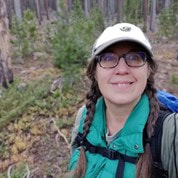 Barb Boyer Buck is the managing editor of HIKE ROCKY magazine. She is a professional journalist, photographer, editor and playwright. In 2014 and 2015, she wrote and directed two original plays about Estes Park and Rocky Mountain National Park, to honor the Park’s 100th anniversary. Barb lives in Estes Park with her cat, Percy. by Cindy Elkins photos by Erik Stensland As a self-proclaimed hermit, the insightful photographer and naturalist Erik Stensland is the entrepreneur behind the Images of Rocky Mountain National Park Gallery in downtown Estes Park, Colorado. He is drawn by the natural world and has a deep passion for wilderness education and preservation. As an author, photographer and program developer, his unlikely path to RMNP was filled with adventure. In 1992 he married the love of his life, Joanna. Together, they set out on a path of service in the Balkan Peninsula of Europe which included living in Austria, Bulgaria, the most remote part of Albania and eventually, Kosovo. For more than ten years he partnered with churches and other organizations to “develop job creation programs.” His efforts to build opportunities for others included developing eco-tourism, a small air service into a remote area, selling local art , and dozens of other things. When the Kosovo war hit, they started a refugee agency and when the war finished, the Stenslands moved into Kosovo to help bring cohesion and communication between over a hundred smaller agencies that were working to help the area recover from the devastation.” During this turbulent time, the Stenslands witness gun violence almost daily; so much so that Erik carried a letter in his back pocket for his wife should he be killed. One can only imagine that burn out and exhaustion would ultimately lead him to ask God for change. In prayer, he specifically asked if it could be on a mountain, have a hiking trail nearby, and much needed solitude. Two days later, a friend asked if he knew of anyone who might want to take an extended break from Kosovo and move to Allenspark, Colorado to live in the basement of their cousin's soon to be built house. Erik said yes; shortly thereafter he and wife Joanna were headed stateside. Erik recognized that he had hit bottom, needed change and his prayers were answered with a new life opportunity. He began an online master's program in organizational development and the family grew to include a son. A few years later, the Stenslands returned to Albania only to find that he was no longer needed there. Returning to the Colorado Rockies they have called Estes Park area home for over 18 years. Once settled in, Erik knew he needed a job and would have to reinvent himself. He was open to what that might be. As an observant person and avid hiker, he noticed beautiful photographic images of nature and wondered, “How do I get paid to hike?” In a conversation with a local gallery owner and wife of a successful photographer, Erik shared that he was considering becoming a professional landscape photographer. Their response was the challenge he needed to spark his next adventure. He was told it was “impossible to make a living with just photography here.” That was all it took to launch his imagination into action. This year, Erik celebrates 17 years of photographing the amazing landscapes of RMNP and the American southwest. Currently Erik has two galleries, one in Estes Park and another in Abiquiu, New Mexico near Georgia O'Keeffe's former residence. Unfortunately, the East Troublesome Fire of October 2020 in Grand Lake, Colorado destroyed the home of those running his gallery space there resulting in them moving and the gallery closing. A new Grand Lake gallery may emerge in spring of 2023. With all of his work, Erik strives to educate photographers and outdoor enthusiasts in the ethics that are needed to truly preserve our wilderness. His foundation The Alliance for Responsible Nature Photography , (Nature First Photography) leads the way in helping others understand the importance of caring for wilderness and respecting the natural environment. “Leading by example and not pointing fingers.” Erik upholds strong values when hiking, or taking photographs. He lives up to and professes seven principles listed on the Nature First website as:
Integrity has three parts to the definition: knowing the difference between right and wrong; acting on doing what is right; and, being willing to speak up, even in the face of adversity, to educate others on what is right. Erik Stensland lives a life that nurtures integrity and helps others to know how to pursue an innate passion of being in the wilderness while standing shoulder-to- shoulder with integrity. He hopes that everyone who enters into RMNP will take the time to understand the fragility of this amazingly strong place. A park ranger friend of his said that Rocky Mountain National Park is experiencing “the urbanization of the wilderness”, referring to how many visitors come and go that do not know how to behave in the wilderness. Let's face it – there are many ways to visit Rocky: a quick drive across the Park including a jaunt around a lake or visitor center and exit through one side or the other; an extended-day visit with lunch somewhere; or, you can take a deep dive into Rocky. Erik wants everyone who visits to abide by a simple understanding of respect. Respect of impact and respect of realizing where you are includes recognizing how many others will come and go beyond your visit. He welcomes others and hopes they leave the land, animals, and beauty for all to enjoy. Take a risk and turn off your phone, your music, listen to the silence and find your inner creative self. Erik's own quest for silence and solitude takes him deep into the Park as he captures each hike on maps. Every adventure, often beginning way before sunrise, each cliff and breathtaking waterfall are captured and categorized in his records so he can continue to find places that he has not been before. Erik strives to climb a new horizon with each mountainous adventure in Rocky Mountain National Park. Rocky has an allure for him; Erik said he suffers from a self-proclaimed “illness when it comes to what's said to be impossible”. He overcame the challenge of “that's impossible” to create his dream job of being paid to hike. His passion to educate others in what is needed to preserve our wilderness areas leads him to write and develop opportunities for others to explore our favorite national park. Erik hopes that his photography will be seen in a way that allows the viewer to “step back and look with fresh eyes, recognizing that nature is a gift.” When asked what some of his favorite areas or subjects within RMNP to photograph are and why? Erik responded with, “I can get as excited as a child at Christmas if I'm at a calm mountain lake with dramatic lighting illuminating jagged peaks surrounded by low clouds. Yet, I can also get very excited to find a simple scene in a forest such as aspen leaves that have fallen into an artistic pattern on a lichen covered rock. In the silence there is an opportunity to slow down, to pay attention, to forget all the other responsibilities and expectations of life. For me that opens the door to really begin to see the wonder of the natural world both big and small.” Currently, Erik is the author of seven books, has a successful online educational program and strives to work with local organizations to assist every visitor to RMNP understand where they are visiting. Erik says: “I hope that this generation and future generations will see the value of wilderness for its own sake. As humans we have this tendency to judge everything by what it does for us, the value it can give to us. That may be viewing a forest for the lumber it can provide, the minerals, water, food, or other that it may contain. Yet we as nature lovers can also do the same and see that same forest only for the recreational opportunities, views, and restoration it can provide us. I would hope that we would all come to view the natural world as having a right to exist apart from ourselves and what we get out of it. I would love it if my photographs could help us recognize its intrinsic value apart from us.” Stop by the Images of Rocky Mountain National Park Gallery; maybe he will tell you about a mountain lion encounter, hikers unknowingly sitting on a frozen elk, or about his adventures into the depths of the Park at night. Listen with both your eyes and ears as he shares photographs, reminds you to walk in the middle of the trail and educates you as to why. |
Categories
All
|
© Copyright 2025 Barefoot Publications, All Rights Reserved
